

MAR/APR 2024 FIREPUMPS SPRINKLERAGE OFFICIAL PUBLICATION OF THE AMERICAN FIRE SPRINKLER ASSOCIATION VOL 43/02
ADVENTURE
AFSA43
AWAITS
Welded throughout without rubber O-Rings or gaskets and 100% leak tested

2” bend radius allowed per UL
Serial identification for tracking
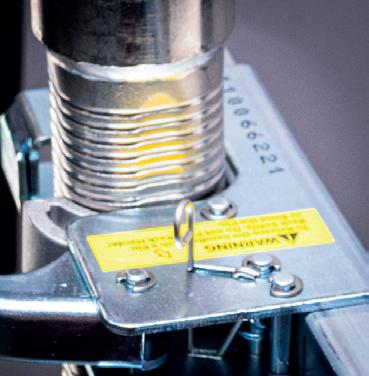
Open hub system for swift and precise repositioning

Easily visible center-of-the-tile marking
100% 304 stainless steel, in lengths of 24”, 31”, 40”, 48”, 60”, and 72”
Overall industryleading welded hose friction loss
Engineered for quick installation with welded adapters, the RFBW minimizes potential leaks.

reliablesprinkler.com/rascoflex-rfbw
The RASCOFLEX® Braided Welded Drop (RFBW)
latest addition to the line of Reliable® Flexible Sprinkler
The
Connections. CONNECT WITH OUR NEWEST FAMILY MEMBER
Trade Agreements Act (TAA) compliant for use in certain “Buy American Act” (BAA) projects

Our new mill expands our overall product capabilities, giving us the most comprehensive range of sprinkler pipe in the industry:
• Diameters from 1” to 10” NPS.
• Schedule 10, 30, 40, and Eddy Flow (size dependent)
• Lengths up to 25’, with custom lengths available
Plus a variety of finishing options — not to mention our exclusive EddyGuard II® MIC antimicrobial coating to help ensure reliable flow for years.
It’s all available to you from a single, responsive supplier…making your pipe selection job much easier.
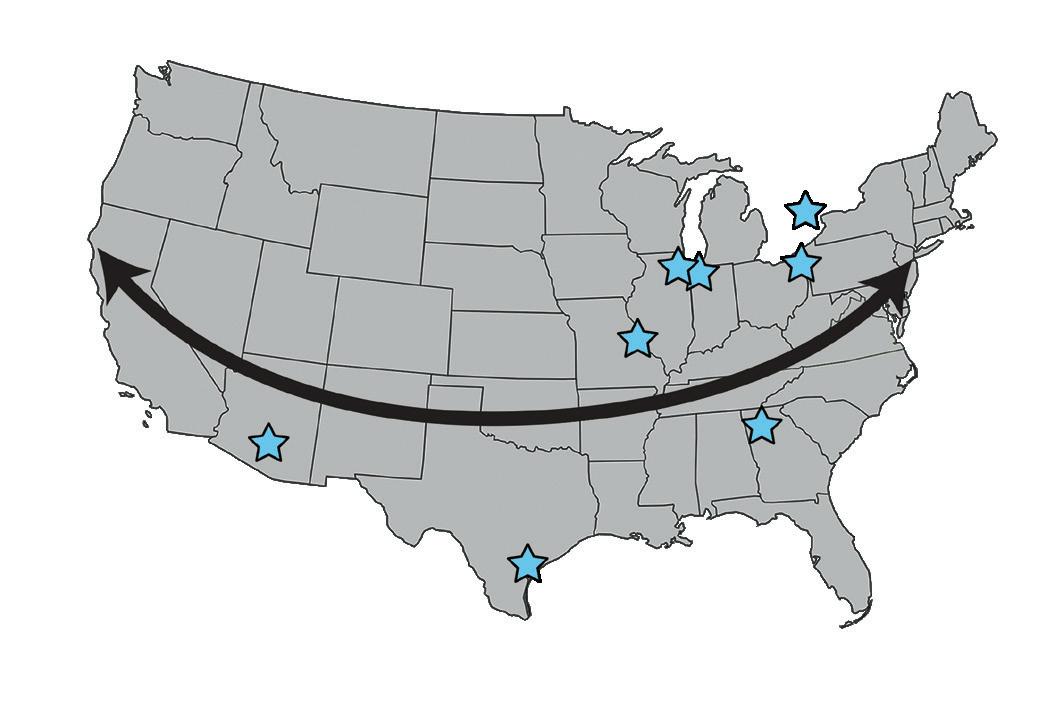
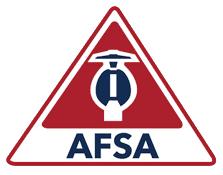
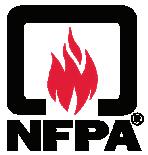


Plants located coast-to-coast... for fast delivery anywhere! BullMooseTube.com | 800.325.4467 Our NEW plant in Sinton, Texas produces 5 , 6 , 8 , and 10
SPRINKLER PIPE.
FULL SERVICE, START TO FINISH

When facing tight physical and logistical windows, it helps to have a dedicated hand at the wheel to ensure everything goes smoothly. Our Project Management service provides expert support and organization at every step of the process; from design to fabrication to the complete package arriving on the jobsite, we’ll anticipate your needs and provide focused, experienced assistance.
VISIT US ONLINE AT FERGUSON.COM/FIRE ©2024 Ferguson Enterprises, LLC 0124 6180410
SCAN TO LEARN MORE

12 |
16 |
The Cheapest Pump is Usually More Expensive in the Long Run
18 |
NAC’s Phase I Exam Helps Evaluate, Prepare, and Showcase Your Apprentices

20
22
24
“It’s So Easy, a Sprinkler-Man Can Do It!”


5 SPRINKLER AGE | MARCH/APRIL 2024
ON THE COVER: Adventure awaits at AFSA43: Convention, Exhibition, and Apprentice Competition, to be held Sept. 18-21 in Denver, Colo.. FEATURES
TAKING AFSA43 TO A NEW HEIGHT Convention, Exhibition, and Apprentice Competition to be Held in the Mile-High City
FIRE
SELECTION AND SIZING
PUMP
THE
IS
“WIN-WIN”
NAC
A
HYDRAULICALLY CALCULATING STANDPIPE SYSTEMS
|
HFSC UNVEILS HOME
STUDIO
|
FIRE SPRINKLER
New Online Tool Offered to Built for Life Fire Departments
| HELP AFSA HELP YOU
Fitter Apprenticeship Programs
| RECOGNIZING APPRENTICE EXCELLENCE Announcing the 2023 National Apprentice Honor Roll
| NEED A HAND WITH CALCULATIONS? Workshops Provide In-depth Training
| TOP-NOTCH TRAINING FOR ITM TECHNICIANS
Offers Comprehensive Programs to Take Inspectors to the Next Level 6 CHAIR’S MESSAGE 8 PRESIDENT’S REPORT 10 FLASHPOINT 34 HIGHER STANDARDS 35 TECHNICAL CHALLENGES 36 #MEMBERSMATTER! 37 NEW MEMBERS 38 AFSA NEWS 38 CALENDAR 39 CHAPTER NEWS 39 ASSOCIATION NEWS 40 AFSA CHAPTERS 41 U.S. CONSTRUCTION 43 PEOPLE IN THE NEWS 44 PRODUCT NEWS 46 INDUSTRY NEWS 46 INDEX OF ADVERTISERS MAR / APR 2024 VOL 43/02 SPRINKLER AGE, (ISSN 0896-2685) is published bimonthly for $33.95 per year by the American Fire Sprinkler Association, Inc., 1410 East Renner Road, Suite 150, Richardson, Texas 75082. Periodicals postage paid at Dallas, Texas and additional mailing offices. POSTMASTER: Send address changes to SPRINKLER AGE, 1410 East Renner Road, Suite 150, Richardson, Texas 75082. Follow us on
Sprinkler
26
29
30
AFSA
CHAIR’S MESSAGE
February 2024 kicked off the new year with my first AFSA Board & Committee meetings as chair. The meetings were very productive and eventful; each committee set clear goals to better serve, you, our members. Convention Committee Chair, Don Kaufman, along with committee members and AFSA staff, are in full planning mode for our upcoming AFSA43 convention at the Gaylord Rockies in Denver, Colo. They are all busy setting up the seminars, choosing exciting venues, and ensuring this will be one of the best apprenticeship competitions and exhibit halls. Start planning your trip to the Mile High City now! Golfers, did you know that in Denver golf balls travel 10 percent farther because the air is less dense, and exerts less drag force on the ball? I would like to welcome Jessica Thomason, Meetings & Events manager, to the AFSA team. Everyone at the Quarter 1 meetings had the opportunity to meet her.
Our technical services and engineering department, led by John Denhardt, P.E., FSFPE, and his team, has broken all records with over 700 technical reviews in 2023. The TAC (Technical Advisory Committee) has been resurrected with Parks Moore, P.E., as chair in an effort to be active on more NFPA committees. Recently, John was re-appointed to sit on the University of Maryland Board of Visitors, and Josh McDonald, MSET, CFPS, CWBSP, WBITM, AFSA’s manager of Technical Services, is working on achieving his P.E.
We have the best-of-class technical team, hands down! Thank you, John, for your leadership, energy, and passion for what you do to make our association the premier place to go to for any code-related issues.
Apprenticeship & Education Committee Chair, Paul DeLorie, reported the AFSA staff delivered 39,000 hours of training to our membership in 2023. The hands-on lab at our headquarters in Richardson, Texas, is 90 percent complete and will increase this number exponentially once completed. The rollout of the VIP hands-on portion of the fitter training in the very near future is very exciting.
With Phil Schechinger serving as chair, the Manufacturers & Suppliers (M/S) Council met and developed a mission statement in support of AFSA and is looking to support the joint mission of our association. We are very appreciative of the support and collaboration we receive from the M/S Council throughout the year.
Our Membership & Chapter Development Chair, Jay Strickland, reported that we have over 1,000 AHJ members. This is due to our president, Bob Caputo’s, emphasis on building stronger partnerships with our AHJs, along with providing needed training in our industry. The committee is also working on updating the AFSA website with support from the AFSA staff. If you have any constructive feedback, please share it with Meda Merritt (mmerritt@firesprinkler.org). Beginning March 1, there will be two regional managers: April Jones will cover the Eastern U.S., and Christina Sales will oversee the Western U.S., focusing on ensuring that chapters have the added support from AFSA.
Continued on page 21

EDITORIAL: 214-349-5965
BOB CAPUTO, CFPS, Publisher, ext. 124 bcaputo@firesprinkler.org
D’ARCY G. MONTALVO, Editor, ext. 115 dmontalvo@firesprinkler.org
ADVERTISING: 214-349-5965
CLARISSA RIOS, Communications Coordinator, ext. 134 crios@firesprinkler.org
CIRCULATION: 214-349-5965
D’ARCY G. MONTALVO, Editor, ext. 115 dmontalvo@firesprinkler.org
AFSA BOARD OF DIRECTORS
LINDA M. BIERNACKI, Chair, 318-841-0330
PAUL DELORIE, First Vice Chair, 603-432-8221
JAY STRICKLAND, Second Vice Chair, 301-474-1136
ROD DIBONA, Treasurer, 605-348-2342
JEFF PHIFER, Secretary, 803-438-2994
JACK A. MEDOVICH, P.E., Immediate Past Chair, 804-222-1381
BROOKS BAYNE, 503-692-9284
TOMMY CLEMENTS, 804-459-2218
LYLE HALL, 858-513-4949
CHRIS JOHNSON, 727-5821-9339
R. DONALD (DON) KAUFMAN, 505-884-2447
MICHAEL F. MEEHAN, 804-459-2200
WAYNE WEISZ, 209-334-9119
AFSA LEADERSHIP
BOB CAPUTO, CFPS, President, ext. 124
JOHN AUGUST DENHARDT, P.E., FSFPE, Vice President, Engineering & Technical Services, ext.121
MEDA MERRITT, Senior Director, Membership Services & Chapter Support, ext. 133
MELISSA ATHENS, Director, Finance & Administration, ext. 112
LESLIE CLOUNTS, Director, Education Services, ext. 130
ROGER GRAGG, Director, Marketing & Information Technology, ext. 116
Sprinkler Age is devoted to the professional development of the fire sprinkler industry. Deadline is 1st of the month preceding publication.
Published by American Fire Sprinkler Association, 1410 East Renner Road, Suite 150, Richardson, TX 75082. Call (214) 349-5965, FAX (214) 343-8898, or email sprinklerage@firesprinkler.org for information.
Copyright © American Fire Sprinkler Association, Inc. All rights reserved. PRINTED IN USA. Unless expressly stated otherwise, all editorial and advertising material published is the opinion of the respective authors and/or companies involved and should not be construed as official action by or approved by Publisher or the Association.
Sprinkler Age is a membership benefit, provided free of charge to AFSA members. For information on non-member and/or foreign subscription rates, call (214) 349-5965.
ABOUT AFSA MEMBERSHIP
AFSA annual membership dues are a sliding scale for Contractors and Associates and a flat fee for Authorities Having Jurisdiction. (Members receive a free subscription to Sprinkler Age.) Write or call AFSA for membership information. See AFSA’s website at firesprinkler.org.
6 SPRINKLER AGE | MARCH/APRIL 2024
LINDA M. BIERNACKI
AFSA BOARD CHAIR
RG3400
ROLL GROOVING TOOL
1 1/4 - 12” OGS & 1”

Use one tool for every groove on the job.
Perform precise, consistent grooves across a wide range of pipe sizes with the new best-in-class roll grooving tool for fire protection projects.
PLUG & PLAY DESIGN
• All necessary components included in one package:
• Integral Motor
• Pipe Stand
• Roll Set Package
• Foot Switch
• Pipe Tape
• Tools
• Storage Bag
INCREASED PRODUCTIVITY
• Set the depth once and perform precise repeatable grooves
• Easily adjust between different pipe sizes & schedules
• Integrated motor with overlaod protection
QUIET OPERATION
• Quietest tool in our offering
• Ideal for occupied spaces - hospitals, schools, offices
© 2024 VICTAULIC COMPANY. ALL RIGHTS RESERVED.
SCAN TO LEARN MORE
PRESIDENT’S REPORT
Why are standards, not standard? I mean the very word itself conjures up thoughts of other words, like normal, typical, common, habitual, or familiar. However, it seems obvious to those of us in the fire sprinkler world that standards, as in NFPA standards, are not applied, enforced, or accepted in any typical or common way. This is especially true when we compare plan review or field acceptance testing to the hundreds of thousands of systems our industry calls for inspections every day! Where am I going with this, you might ask? We here at AFSA receive dozens of requests for Technical Reviews every day, often from the same two entities arguing over the same section of a code or standard on the same project.
Now, don’t get me wrong, the AFSA Technical Services Department is happy to assist in any way possible, and we don’t judge. In fact, this kind of activity is largely why we’re here. I assure you that we love this part of the job because it helps us understand what part of the codes and standards need work to make the language and the intent clearer for all users.
Water-based fire protection systems are designed to codes, standards, and project specifications, usually NFPA standards which are read and applied by layout technicians and reviewed by plans examiners. While all stakeholders are reading from the same rule books, things seem to get a little out of whack when two people read the same document with differing interests in mind. This is even more the case when money is involved! In 1992, when Rodney King asked something to the effect of,“Can we just all get along?” I remember thinking to myself, he must not be a fire sprinkler layout technician, fitter, or work in the fire prevention bureau! But wait, aren’t we all reading and applying the same codes and standards? Singing from the same hymnal? Focused on fire prevention and life safety? Of course we are.
Like most problems, solutions are the result of communication, and good communication usually doesn’t start until after the frustration passes and we start to think about reasonable and viable solutions that can fit everyone’s narratives and objectives. In our industry, the objectives can vary, making it difficult to get buy-in and please all stakeholders, so let’s look at the players, their roles, and their objectives in a construction project:
First, we have the owner, perhaps a lender or lending institution, architects, engineers, a general contractor, subcontractors, including a fire sprinkler contractor, materials suppliers, a fabricator, municipal plans reviewers, and municipal field inspectors, not to mention a possible engineer of record or sprinkler layout technician, and installers, all of whom want to make money in the process of delivering or reviewing the project. NFPA 13 says the system design method gets selected by the designer of the system, but the Authority Having Jurisdiction (AHJ) must approve the selection… checks and balances. That sounds like the great system of governance we learned about in 5th grade social studies class. By the way, the municipal authority isn’t the only one who is considered the AHJ, but their
department is the primary first responder when something bad happens. As such, they get to decide what is appropriate for their jurisdiction. The municipal plan reviewer has the purview to ask for anything he/she wants, though we assume they will enforce their adopted codes and standards in a uniform way.
I have the privilege of presenting seminars for multiple organizations on a variety of related topics but the issue where I find the most controversy continues to be in plan review. I think this is because we try to communicate through digital or print means, as opposed to getting together and having a discussion to share the information, decisions, and desired outcomes. Think about how many back-andforth email messages we send and receive before we just pick up the phone and have a conversation… problem solved. I think we should apply that same solution to the plan review process, where things are complicated and can be more easily explained in person.
Regardless of the conflict, on or off the job, communication is the key to resolution. To be effective, communication has to be timely and hopefully polite, considerate, and early enough in the timeline of a problem to save everyone’s pride, ego, and money. For most of us in construction, that means asking questions before we install something that might be controversial. Asking questions and getting agreement early in the process allows projects to go better because we solved the conflict before it became one. Making decisions in a democratic way, with other stakeholders allows us to implement those decisions as a dictator, since we all agreed up front. Trying to find solutions and resolve issues after systems or components are installed, after plans have been reviewed and accepted or approved, is neither cost-effective nor fair to the owner of a building or business.
The world of commerce, like technology itself, has changed a lot in the past 10 or more years, and the rate of change continues to accelerate. The reality for contractors and AHJs alike is that we need to work together to ensure the built environment is safe for occupants, while allowing commerce to prosper in our communities. Allowing healthy businesses to grow and contribute to the financial health of our towns, cities, and states by contributing tax dollars for municipal programs, police and fire salaries, etc.
We are all in this together for the common good, for fire and life safety and for the prospering communities we live in. This thing of ours, the wonderful and amazing business of fire protection, is something we can and should all be proud to be a part of—and yes, we can all get along, united by a common cause and guided by the codes and standards we design to, build to, and enforce. n
BOB CAPUTO, CFPS AFSA PRESIDENT

8 SPRINKLER AGE | MARCH/APRIL 2024
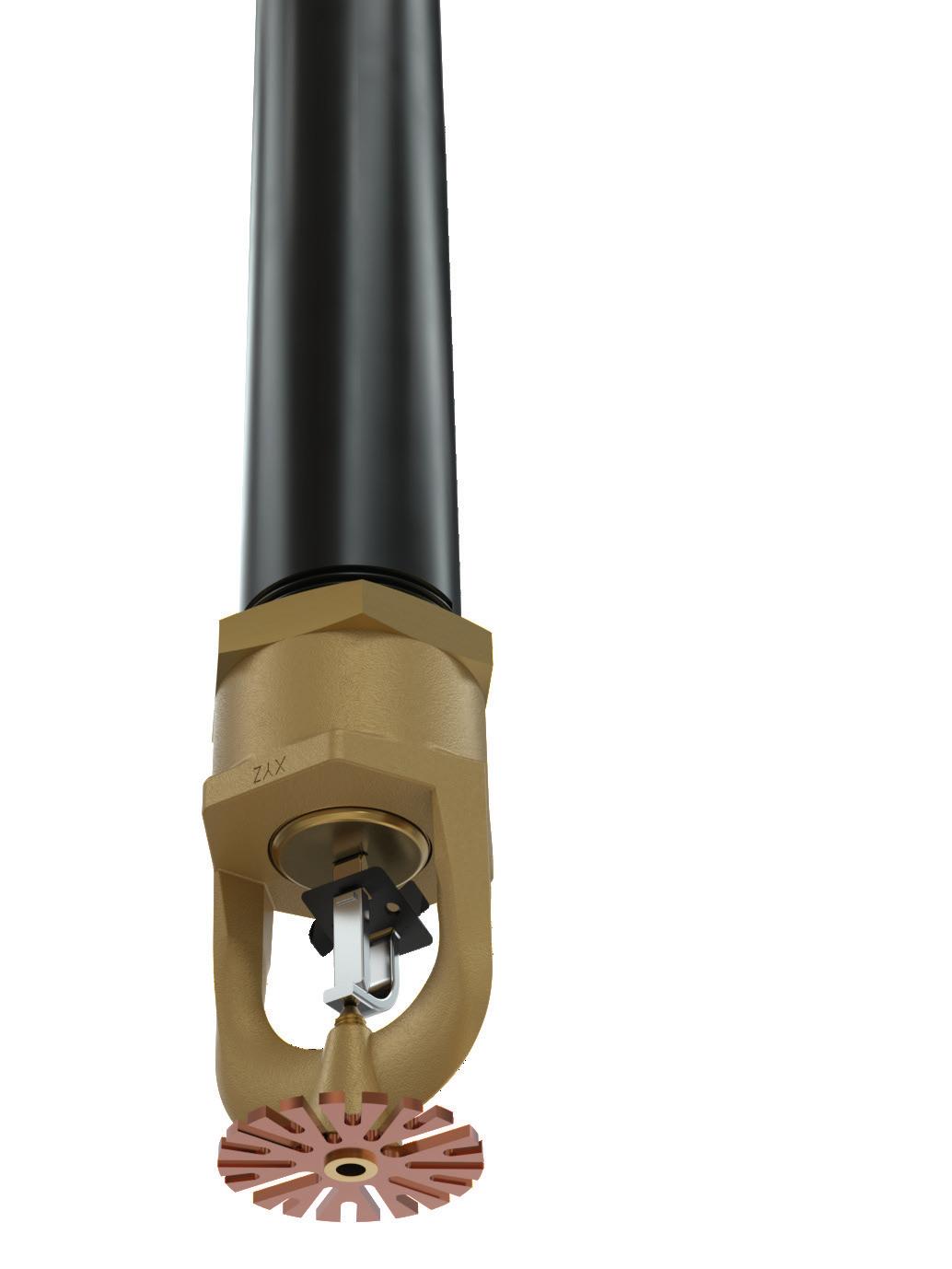
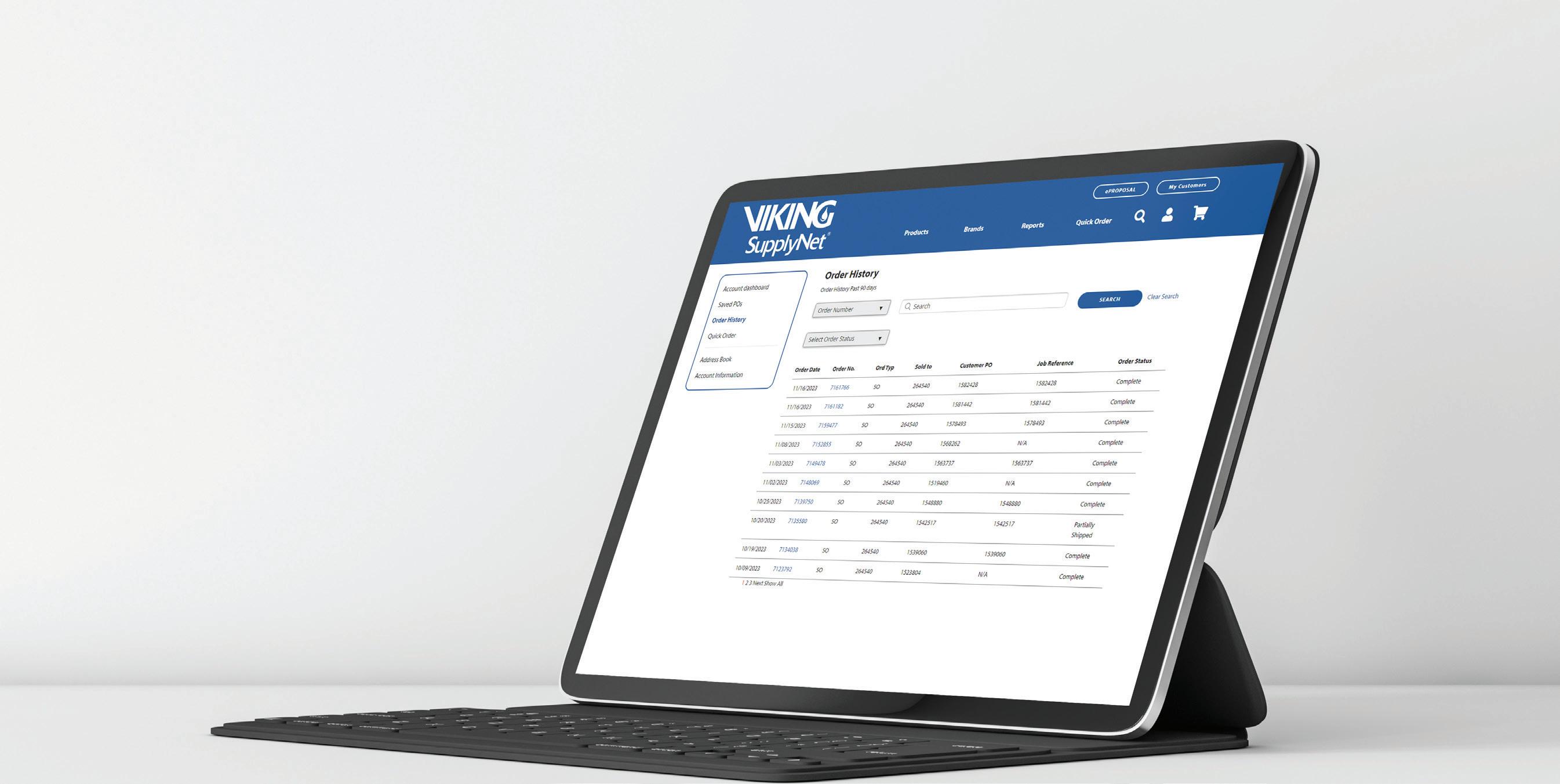
Say Goodbye to Uncertainty with Order Tracking and Custom Pricing
Make ordering simple with SupplyNet.com! We make it a breeze to get what you need, when you need it.
Custom Pricing: With SupplyNet.com you can browse thousands of products from the industry’s leading brands while accessing your real-time customer pricing. Place orders to your local Viking SupplyNet with the click of a button.
Order Tracking: From warehouse departure to on-site delivery, stay in the loop at every stage of your order’s journey. No more guesswork—just real-time updates to keep your projects on schedule.
Discover a smarter way to source and order the products you need. Learn more at supplynet.com.
Get started with your own SupplyNet.com account and take advantage of custom pricing, order tracking and more. Scan the QR code or head to supplynet.com to register today.

Track orders and check pricing with SupplyNet.com
FLASHPOINT
With the changes to automobile vehicles over the years and the method in the way parking garages are designed, the model building codes and the sprinkler installation standards have been modified for fire protection of these structures. However, these modifications have not fully addressed the issues.
For years, if a parking garage was sprinklered in accordance with NFPA 13 most engineers classified the vehicle parking area as an ordinary hazard group 1 (OH1) hazard. During the 2022 revision cycle, the annex of NFPA 13 was changed from recommending an OH1 to indicating an ordinary hazard group 2 (OH2). Being directly involved with this change showed me the fundamentals and complexity of this issue. The technical committee on sprinkler system discharge criteria had proposals from several sources to make the hazard classification change from OH1 to OH2, extra hazard group 1 (EH1), extra hazard group 2 (EH2), or remove the recommendation altogether. In fact, the first action of this technical committee was to remove the recommendation altogether.
AFSA opposed this first action for several reasons. The OH1 recommendation had been in the standard for years, and to remove it altogether seemed strange without specific evidence. We did understand the fires that occurring in unsprinklered properties were becoming a major loss. We felt some guidance should be given. After many hours of discussion, the technical committee agreed on the OH2 recommendation.
The technical committee statements on the change are very telling. The first revision number 1201 stated, “Fire protection in parking structures, whether open or closed, provides property protection. The NFPA FPRF report (Modern Vehicle Hazards in Parking Structures and Vehicle Carriers) has shown evidence that fires in parking structures not protected by sprinklers can become major conflagrations leading to catastrophic losses. The technical committee welcomes public comment on this topic for review and discussion at the Second Draft meeting.” The second revision number 1191 stated, “This language has been clarified to show sprinklers are to be provided in all parking structures and that NFPA 13R has been added to provide sprinklers in low-rise residential structures.” We agreed. The vehicle your grandparents drove, the vehicle your parents drove, the vehicle you drive, the vehicle your children (will) drive, and the vehicle your grandchildren (will) drive have evolved over the years. The increase in the use of plastics, the decrease of metal, and the size and weight of the vehicle have changed. The fuel type has also changed. Besides gasoline and diesel-powered vehicles (aka internal combustion engines or ICE), electric-driven vehicles are increasing. What does all this mean? We just do not know how to protect the modern and future vehicles. However, just like every problem, we will find an engineering solution.
We also must consider the way we park and store the vehicles. In general, parking spots have been shrinking, while there is still a large demand for larger SUV and truck-type vehicles in the United States. Vehicle stacker garages are becoming popular in areas where real estate is at a premium. When we park
or store vehicles close, the probability of a fire spreading from one vehicle to another increases. We have little data to provide proper sprinkler protection in any vehicle stacker garages over two levels.
There are several different active research programs trying to provide information for us to get ahead of this situation. One of these is the National Fire Protection Research Foundation’s program called “Classification of Modern Vehicle Hazards in Parking Structures and Parking Systems – Phase II.” AFSA is participating in the technical panel and has also partially funded this research. We need answers to provide guidance to our industry.
We can state current model building codes and NFPA 88A, Standard for Parking Structures, 2023 edition, require sprinkler protection for all parking garages. Kevin Hall and I are the AFSA representatives on this technical committee. Section 6.4 states:
6.4 Sprinkler Systems
6.4.1 Automatic sprinkler systems shall be installed in all parking structures in accordance with NFPA 13 and NFPA 13R as applicable.
The technical committee statements for this language were also very telling. “Automobile materials have changed substantially since parking garages were considered OH1. Not enough information is currently available to appropriately classify parking garages.” The second revision number 1191 stated, “Based on the increase of plastics and other challenges that modern vehicles present, a higher hazard level of protection is more appropriate. Further research in this area is needed.”
Currently, sprinkler protection is “typically” being designed to OH2 for a standard parking structure, but it is ultimately the engineer’s responsibility to classify the hazard for a particular project. In addition, does the sprinkler spacing impact the performance of the system? Can extended coverage sprinklers produce acceptable results? How long does the water supply have to last? Does the response type of the sprinkler matter? What temperature classifications of the sprinkler produce the best results? How does a dry pipe system impact the fire loss? The research is showing some interesting data, but to state we have answers to these types of questions would be misleading.
This issue will continue to develop, and the research will lead us to engineering solutions. AFSA will continue to be involved and will keep our members informed. We will ensure the contractor’s perspective is known to the technical committees and panels. Let me know your thoughts, and consider this: Would designing and installing a parking garage to an EH2 hazard classification be reasonably possible in areas subject to freezing conditions? Remember, all obstructions are required to be accounted for in an EH2 design, not just structural elements. I look forward to hearing your thoughts. n
JOHN AUGUST DENHARDT, P.E., FSFPE AFSA VICE PRESIDENT OF ENGINEERING & TECHNICAL SERVICES

10 SPRINKLER AGE | MARCH/APRIL 2024
Advanced Air Supply Equipment
FOR DRY & PRE-ACTION FIRE SPRINKLER SYSTEMS
• UL 1450 Listed for Fire Protection
• Fastest Installation and Set Up Saves Big On Your Time
• Minimize Maintenance with Included Auto Tank Drain
• Set Compressor for Low, Standard or High Pressure Applications by pressing a button!
UL Listed Digital Pressure Switch Features:
• View Holding and Set Pressures
• View and Record Run Hours
• View Running Amperage
• View and Record Compressor Cycles
The ADVANCE Series from General Air Products is the most technologically advanced fire protection air compressor on the market. Installed in a flash compared to standard models, the UL Listed digital pressure switch is wired out of the box for all standard pressure settings. The ADVANCE series is also the only fire protection air compressor available that will automatically drain the tank of water.
Use this QR Code or contact us to learn more!
Vapor Pipe Shield from General Air Products is the newest product for corrosion mitigation in Dry and Pre-Action fire sprinkler systems. Utilizing VpCI Vapor Corrosion Inhibitors that have been mitigating corrosion in industries around the world for over 40 years, Vapor Pipe Shield will save you significant amounts of time and money compared to existing technologies.

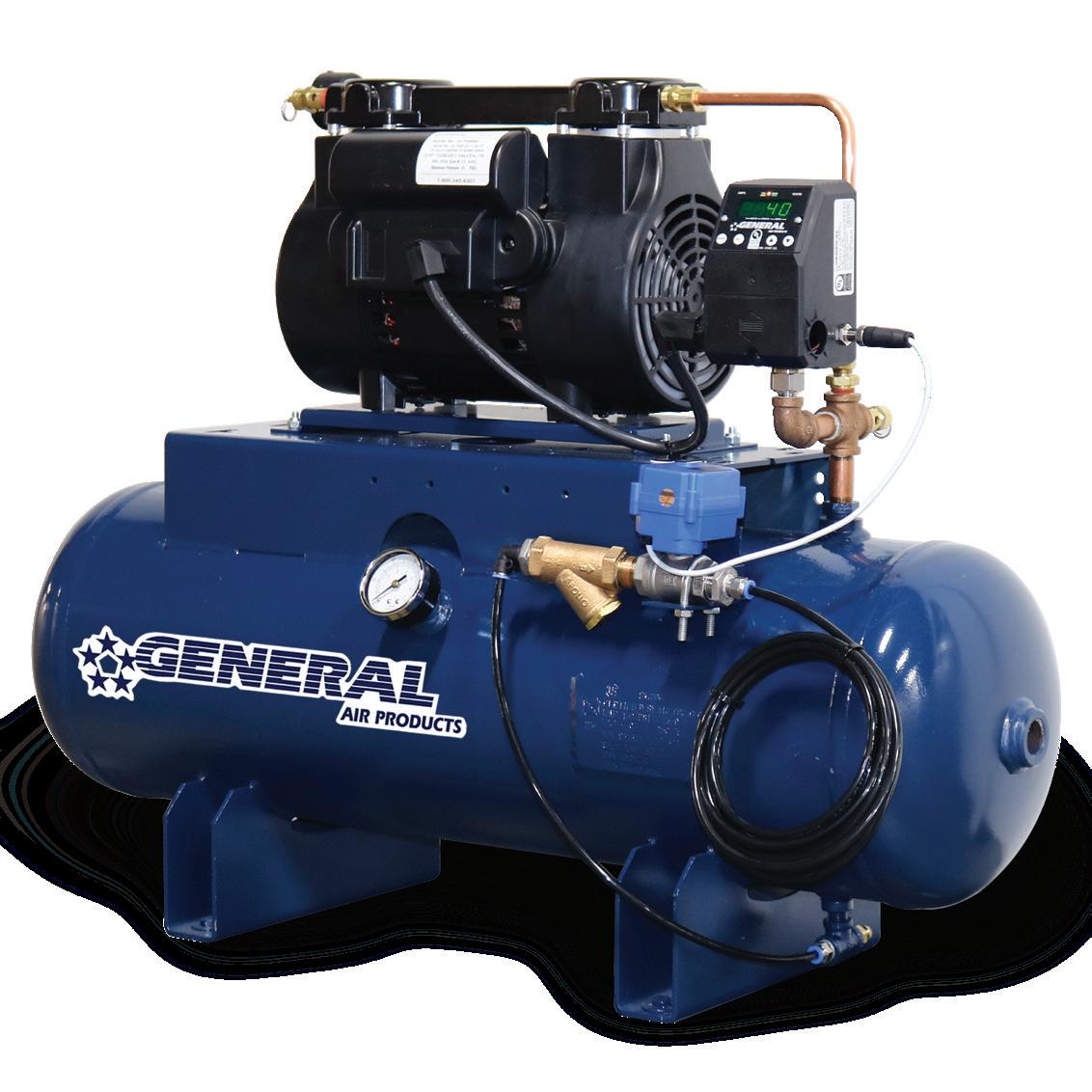



Use this QR Code or contact us to learn more!
Corrosion Prevention. generalairproducts.com
Simplifying
TAKING AFSA43 TO A NEW HEIGHT
CONVENTION, EXHIBITION, AND APPRENTICE COMPETITION TO BE HELD IN THE MILE-HIGH CITY
CLARISSA RIOS | AMERICAN FIRE SPRINKLER ASSOCIATION
Mark your calendars and pack your bags for Denver, Colo., from Sept. 18-21! The American Fire Sprinkler Association (AFSA) is hosting its Annual Convention, Exhibition, and Apprentice Competition miles higher than ever before. Join AFSA at the Gaylord Rockies Resort & Convention Center, Colorado’s largest combined resort and convention center. Witness the alpine charm of Colorado while attending the largest fire sprinkler exhibit in North America.
Connect and network with key industry players, receive top-tier training, and listen to educational seminars. Don’t miss out on the chance to earn CEUs and CPDs, watch the live apprentice competition, and attend all of the exciting social events that AFSA has planned.
“I’m excited to see everyone this year in Colorado at AFSA43,” states AFSA’s Manager of Meetings & Events Jessica M. Thomason. “We strive to offer the best educational seminars and technical content in the fire sprinkler industry. This year, we are raising the bar over four days with an extensive agenda with more networking events, technical sessions, the annual apprentice competition, and a little adven -
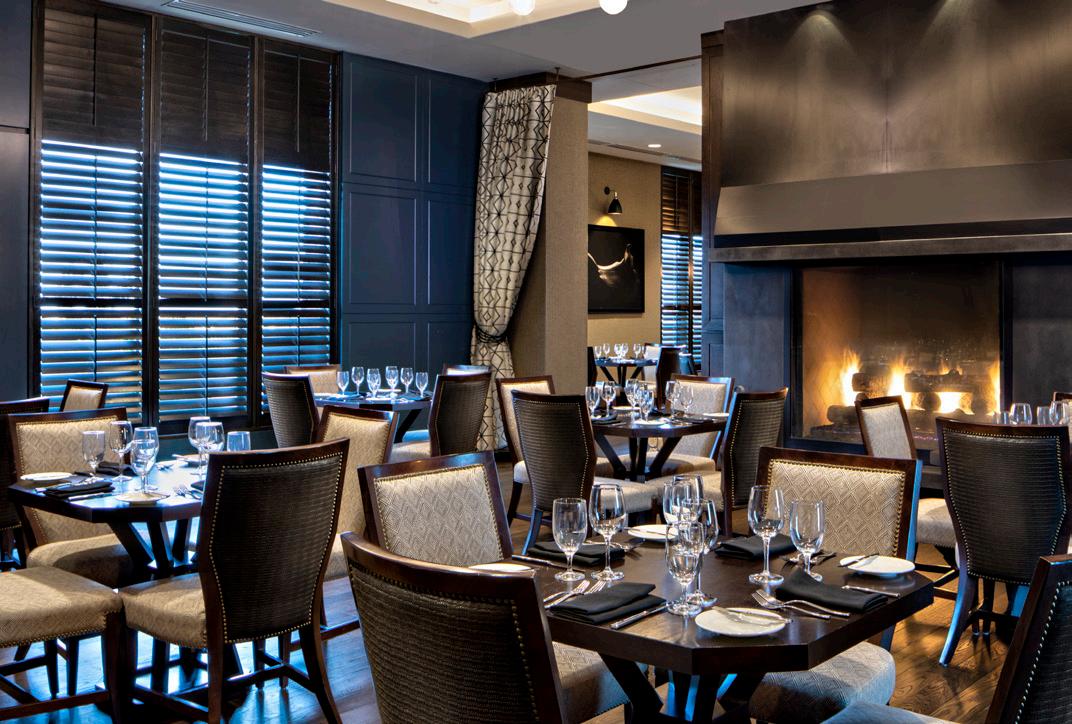
ture mixed in. I hope you join us at the Gaylord Rockies Resort in September—adventure awaits!”
EDUCATION AND ENTERTAINMENT
AFSA43 will offer four days of managerial and technical seminars filled with education, training, and networking led by industry experts. Educational seminars will cover multiple tracks across all aspects of the industry. AFSA’s exhibition provides an opportunity to meet with leading manufacturers and suppliers of the latest products and services offered in the fire sprinkler industry. The unopposed exhibit hours allow attendees and exhibitors to visit without interruption, and the second day of exhibits features the finals of AFSA’s 31st National Apprentice Competition (NAC).
Convention highlights include the Opening Party, Exhibition Grand Opening Reception, general session, final night Awards Party, social events, and a chance to relax with friends new and old during the convention networking meals.
This year’s Awards Party will be celebrated at the Gaylord Rockies’ pavilion on the final night of the convention—Saturday, September 21. Guests will enjoy a night of dancing, dining and live entertainment. Come celebrate with AFSA amid the natural

12 SPRINKLER AGE | MARCH/APRIL 2024
AFSA43 attendees can enjoy five restaurants, bars, unique culinary experiences, and special restaurant events during their stay.
Bask in the refined, rustic décor of the Gaylord Rockies Resort’s luxury hotel rooms.
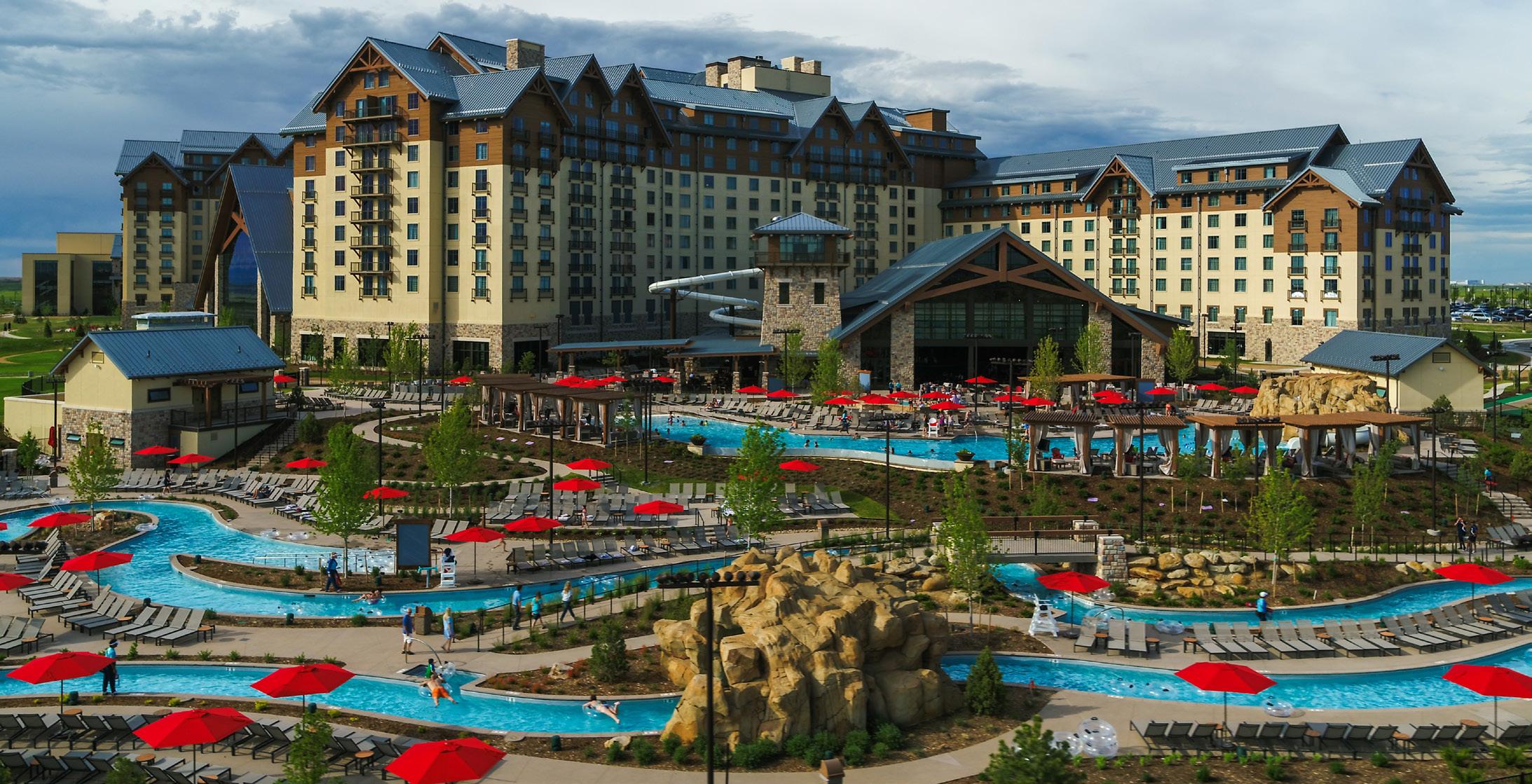
beauty of Colorado and find out who will be awarded this year’s NAC champion!
AFSA MEETS DENVER LUXURY
AFSA treats its members with quality benefits and services. As an organization, it ensures members receive the best in their hotel rooms and accommodations. AFSA has secured the Gaylord Rockies Resort & Convention Center in convenient proximity to the airport. The hotel offers scenic mountain views, five beautiful restaurants, a fitness center, a world-class spa, and the exciting Arapahoe Springs Water Park with indoor and outdoor pools, a lazy river, waterslides, sunbathing decks, and whirlpools. The pools are also heated and open all year long.
Several exciting new things are being renovated at the Gaylord Rockies. The hotel is launching a unique dining experience, remodeling its Grand Lodge, and building a new event pavilion. The outdoor lawn spaces have also been redesigned, providing a more spacious and elegant location for guests. AFSA will utilize these locations for meetings and events, as most of these will be completed in time for the convention and attendees to enjoy.
The AFSA group rate for the Gaylord Rockies Resort & Convention Center is $259 per night plus tax for single/double rooms. Guests are welcome to stay at the hotel from Sept. 17 –Sept. 22. Reservations must be made by Thursday, Aug. 21, to secure the convention group rate. After Aug. 21, group room rates are based on availability. Be sure to book your stay with the hotel directly by phone call or the link that will be uploaded to the AFSA convention site to receive the correct group pricing.
AFSA is not represented by travel agencies or housing companies, such as Global Housing, that may try to book your
room outside of our room block. Be aware of third-party vendors soliciting AFSA exhibitors and attendees posing as our housing vendor. These companies mislead you into thinking they are working on our behalf but are NOT endorsed by or affiliated with AFSA. Book directly with Gaylord Rockies Resort & Convention Center to ensure your reservation is guaranteed.
WHAT TO EXPECT
The mountains are calling, and AFSA is answering with a four-day adventure in Denver. Past convention goers may know the key convention events such as apprentice competition, networking meals, and, of course, AFSA’s infamous parties. To start strong, there will be an opening party upon arrival. There will be three networking breakfasts and lunches and an awards party to conclude the event. Listen in on expert-led seminars for employers and their staff; take advantage of opportunities to earn credits; walk through a packed exhibit hall with companies worldwide, enjoy delicious food and drinks; and experience all the fun in between.
“I look forward to welcoming you all to one of our most beautiful convention sites at the Gaylord Rockies!” comments AFSA Chair of the Board Linda Biernacki, Fire Tech Systems, Inc., Shreveport, La. “This location has something for everyone in your family and co-workers. Get ready for a packed schedule of events starting on Wednesday with a Leadership Conference, Women in the Industry Cocktail Reception, New Attendee Reception, and culminating with our popular Opening Party. It’ll be a fun kick-off to our Mile High of events!”
This event will put you in the right conversations with the right people. Past convention attendees confirm they receive superior connections and increase business networking. The
13 SPRINKLER AGE | MARCH/APRIL 2024
The Gaylord Rockies Resort & Convention Center showcases the state’s alpine charm and offers a welcome reprieve from the typical mountain resort stays. Enjoy the thrilling Arapahoe Springs Water Park and an array of family-friendly activities and entertainment.

INTERESTED IN EXHIBITING?
Attendee traffic is going to be huge! This year’s convention schedule will allow all exhibitors plenty of time with attendees to network, showcase, and create relationships. The NAC always reels viewers in, so you’ll want to ensure you’re present at your booth during the competition. There will also be several time-slotted opportunities for guests to peruse the exhibit hall and see all exhibitors. AFSA ensures traffic in the hall through:
• Unopposed exhibit hours. AFSA carefully schedules each day of the convention to avoid seminars and social events conflicting with exhibit hall hours.
• National Apprentice Competition. AFSA’s NAC is held each year in the exhibit hall. This popular event draws convention attendees to view the installation portion of the competition and puts them within your reach.
National Apprentice Competition is a fan favorite for convention guests and an excellent opportunity for the seven national finalists to compete with the best of the best. A complimentary all-expense-paid trip is offered for those participating. Participants also walk away with new tools and cash prizes. If you’re interested in competing or for competition guidelines, visit www.firesprinkler.org/competition/.
BE AN AFSA43 SPONSOR
AFSA expects a big turnout this year for attendance. For all companies looking to put their brand and offered services in front of an industry-targeted crowd, AFSA43 is open for sponsors. AFSA43 sponsors are offered special benefits by levels: Diamond, Platinum, Gold, Silver, and Bronze. Booth selection will be based on a point system within each sponsorship level, from Diamond to Silver. Benefits vary throughout each level, and as levels increase, so does the available exposure and visibility to convention attendees. Benefits are provided throughout the convention with online exposure, increased visibility, and face-to-face opportunities. Some of these benefits include:
• Priority booth selection for sponsors at the Diamond, Platinum, Gold, and Silver levels (AFSA members only). Booth selection will be based on the current point system within each sponsorship level, from Diamond to Silver.
• Room-access key cards. Diamond sponsors will have their logo featured on hotel room key cards.
• Diamond sponsors will have added exposure with company branding on the Gaylord Rockies’ giant screen during the entire event.
• Diamond sponsors will have their logo prominently displayed as guests arrive at the Opening Party.
• Diamond sponsors receive a sponsored blog post on SprinklerAge.com with automatic social media postings on AFSA’s pages.
Sponsorships must be entirely paid by April 26 to take full advantage of publicity. More details will be available soon at www.firesprinkler.org/afsa43/.
• Exhibition Grand Opening Reception. AFSA’s Chair of the Board of Directors hosts this popular evening event, allowing convention attendees to tour the exhibit hall and enjoy hors d’oeuvres and a cash bar.
• Free passes for the second day of exhibits. AFSA invites local Authorities Having Jurisdiction (AHJs) and exhibitorinvited guests to visit the exhibit hall.
Sponsors also enjoy exhibitor benefits at AFSA43. Diamond and Platinum sponsorship levels include one 10-ft x 20-ft booth, and Gold sponsorship level includes one 10-ft x 10-ft booth. Additional booths are available for purchase to expand the size.
Diamond sponsors receive three all-access registrations and six exhibit-hall-only registrations. Platinum-level sponsors receive two all-access registrations and four exhibit-hall-only registrations. Gold sponsors receive one all-access registration and two exhibit-hall-only registrations.
Exhibitor and sponsor registration opens on March 18. First come, first served! If you’re ready to start planning and securing the best spots and publicity for your business, contact Thomason at jthomason@firesprinkler.org.
STAY UPDATED
AFSA43 attendees registration opens on May 18, 2024. Bookmark AFSA43’s official website at www.firesprinkler.org/ afsa43/ to view more details and register. Get real-time updates on the association’s official happenings sent to your desktop or wireless device by subscribing to or following AFSA social media, and use our official hashtag #AFSA42.
• TikTok: tiktok.com/firesprinkler.org
• LinkedIn: linkedin.com/company/american-fire-sprinklerassociation-afsa-/mycompany/
• Facebook: facebook.com/firesprinkler.org
• Instagram: instagram.com/firesprinklerorg
Don’t miss out on the fire sprinkler industry’s best event of the year! AFSA and the Gaylord Rockies Resort are thrilled to see you in the Mile-High City! n
14 SPRINKLER AGE | MARCH/APRIL 2024
Guests can relax on the beautiful new Grand Lodge Lawn with stunning mountain views.

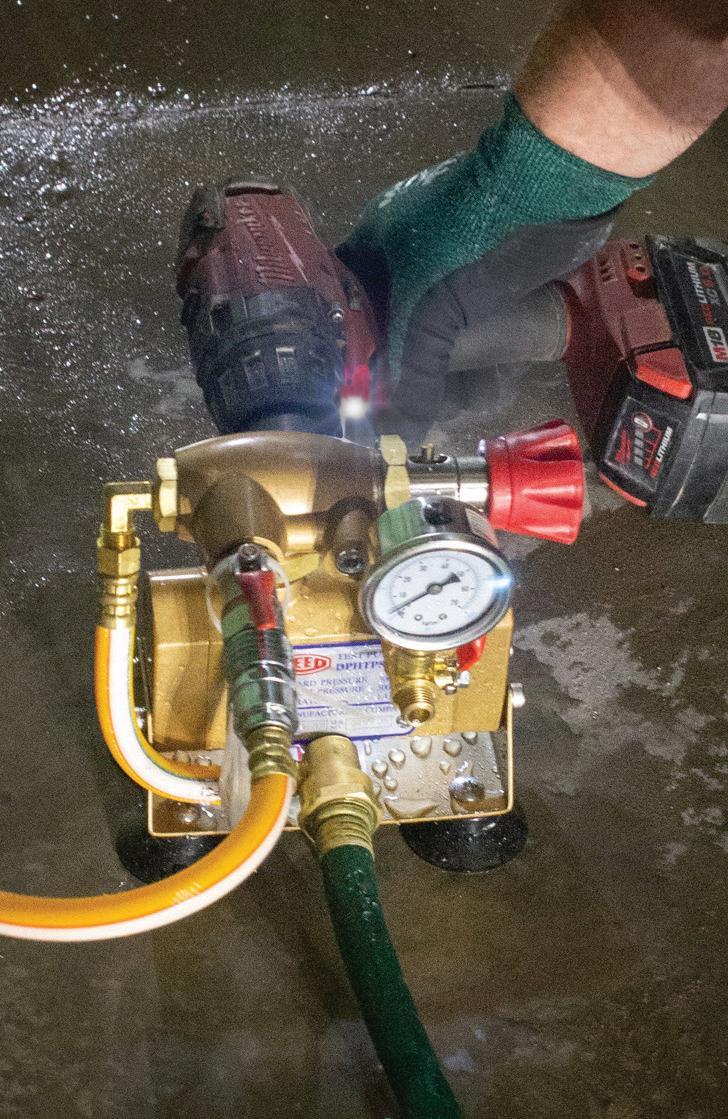

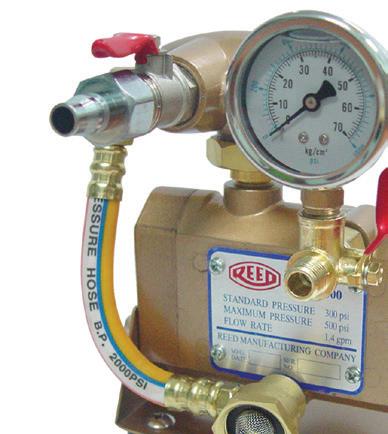


HYDROSTATIC TEST PUMPS • Pressure test water systems, both residential and commercial PERFORMANCE UNDER PRESSURE EHTP500 ELECTRIC 2 gpm, 500 psi max DPHTP500 DRILL-POWERED 1.3 gpm, 500 psi max Reed Manufacturing • Erie, PA USA 800-666-3691 • reedsales@reedmfgco.com www.reedmfgco.com
FIRE PUMP SELECTION AND SIZING
THE CHEAPEST PUMP IS USUALLY MORE EXPENSIVE IN THE LONG RUN
JOHN AUGUST DENHARDT, P.E., ET, CWBSP, FSFPE | AMERICAN FIRE SPRINKLER ASSOCIATION
It has amazed me during my career that so many people seem to think the sizing of a fire pump system is magical. Engineers, technicians, and Authorities Having Jurisdiction (AHJs), in many cases, do not understand how to select a fire pump for a specific project. The proper selection should comply with the installation standard, specifically NFPA 20, Standard for the Installation of Stationary Pumps for Fire Protection, the insurance company’s and engineer of record’s requirements, all AHJ regulations, and be cost-effective for the contractor in the overall project scope of work. A contractor who selects a fire pump strictly on a specified rated flow and pressure that is the lowest cost DOES NOT understand the selection process. You want to purchase a fire pump that you WANT to buy. Let’s get into the details.
Every fire pump is a unique piece of equipment. However, NFPA 20 requires certain parameters for a fire pump to be listed by the listing agencies. A fire pump must have a manufacturer’s rating in terms of flow rate and boost pressure. NFPA 20, 2022 edition, Table 4.10.2 has a list of available fire pump sizes. At the rated flow rate, the fire pump must produce the rated pressure. Period! That is the only fixed point NFPA 20 defines. At no flow (otherwise known as churn), a fire pump must produce at least 100 percent of the rated pressure but no more than 140 percent of the rated pressure. The manufacturers can produce a fire pump that has a low boost (around 105 percent at no flow or a pump with a high boost (around 130 percent) at no flow. Either fire pump would meet NFPA 20 requirements. At 150 percent of the rated flow, the fire must produce at least 65 percent of its rated pressure but not more than 100 percent of its rated flow. Once again, the manufacturers have the choice to produce the fire pumps they want to sell.
A fire pump with a flat curve (a curve that is close to 110 percent of rated pressure at no flow and 75 percent or more of rated pressure at 150 percent of rated flow) does have many advantages to most designers. However, these flat curve fire pumps possibly require a higher power-rated driver and are typically more expensive. A fire pump with a steeper curve (a curve that is close to 130 percent of rated pressure at no flow and around 70 percent or less of rated pressure at 150 percent of rated flow) tends to utilize smaller power-rated drivers and is typically less costly.
In most cases, every manufacturer has multiple selections at the same rated conditions. For example, let’s look at four different fire pumps with the same rated conditions.

Diesel-driven fire pump.
Example number 1:
Rating: 1,000 gpm @ 100 psi boost pump
Speed: 1760 rpm
Churn pressure: 121 psi
1,500 gpm: 71 psi
Driver: 75 hp
Example number 2:
Rating: 1,000 gpm @ 100 psi boost pump
Speed: 1760 rpm
Churn pressure: 134 psi
1,500 gpm: 68 psi
Driver: 50 hp
Example number 3:
Rating: 1,000 gpm @ 100 psi boost pump
Speed: 3560 rpm
Churn pressure: 132 psi
1,500 gpm: 65 psi
Driver: 50 hp:
Example number 4:
Rating: 1,000 gpm @ 100 psi boost pump
Speed: 1760 rpm
Churn pressure: 105 psi
1,500 gpm: 84 psi
Driver 100 hp
16 SPRINKLER AGE | MARCH/APRIL 2024
Which fire pump has the lowest cost? Which one is the most costly? Which one is the best and most economical for your specific project? They are all listed and comply with NFPA 20 requirements. Fire pumps are not a commodity. Picking the more expensive fire pump might allow your designer to reduce the mains in a warehouse sprinkler project from 6 in. to 4 in. The reduction of the main sizing in terms of labor and material savings could easily cover the increase in the cost of the fire pump. A complete review of every project needs to be performed. This includes the available water supply to the fire pump system, the electrical infrastructure available for an electric-driven fire pump system and for a diesel-driven fire pump if needed, the alternative power supply capabilities, fuel tank size, ventilation requirements, and more.
Also, keep in mind in terms of flow rate. A fire pump can supply any demand between no flow and 150 percent of its rated capacity. If the most demanding system has a flow rate of 1,286 gpm, a 1,000 gpm can be used. A.4.10 recommends the fire pump be selected between 90 percent and 140 percent of its rated flow; however, this is not a requirement. In fact, I usually selected a fire pump that was never beyond 135 percent of its flow rate. This is because any sprinkler system we designed can have only one sprinkler operate, so the lower flow rate is not critical. Again, a fire pump can be used anywhere in its flow range from 0 percent to 150 percent of its rated flow.
The speed of the fire pump is also not important. Engineers like to specify “low” rpm fire pumps (1,800 rpm or lower) so they do not wear out prematurely. This is nonsense. Fire pumps operate very infrequently, and the wear due to the speed of the pump is inconsequential. Also, some engineers look at the “efficiency” rating of the pump. Again, ridiculous. The fire pump is very seldom operated, and the cost of efficiency is insignificant.
The maximum working pressure of a sprinkler system is not 175 psi. It is whatever pressure the components are rated at. It is becoming normal to exceed 175 psi. Most components are easily rated for 250 psi without any additional cost. The one exception to this is sprinklers protecting Extra Hazard or Storage occupancies. In these two hazards, pressure is limited AT THE SPRINKLER to 175 psi. The designer can take advantage of elevation loss to select a higher-pressure fire pump.
In summary, every project that requires a fire pump needs a detailed review to select the “best” fire pump for the job. n
ABOUT THE AUTHOR: John August Denhardt, P.E., ET, CWBSP, FSFPE, is the vice president of engineering and technical services for AFSA. He is a registered professional engineer (P.E.) in the District of Columbia and Delaware, Maryland, Pennsylvania, and Virginia. He is NICET Level III certified in water-based systems layout, NICET Level III certified in inspection and testing of water-based systems, and a certified water-based system professional through NFPA. Denhardt is an SFPE fellow, member of the NFPA 13 technical committee on sprinkler system discharge criteria, member of the SFPE Board of Directors, member of the NFPA’s Fire Protection Research Foundation board of trustees, and sits on the University of Maryland Department of Fire Protection Engineering’s Board of Visitors. He holds a Bachelor of Science degree from the University of Maryland College Park in fire protection engineering.


Now Available on Select COLLECTanDRAIN Models
The M5900 stops flooding caused by auxiliary drains that freeze and break, are maintained improperly, vandalized, or broken by accidents. They enable facilities to recover faster with less clean-up and expense.
• For Dry and Pre-Action Sprinkler Systems
• Compatible with Air and Nitrogen
• No Power Required
• Automatically Resets
• Allows Condensation to be Drained Normally
• Retrofit onto Existing Auxiliary Drains
• Made in the USA
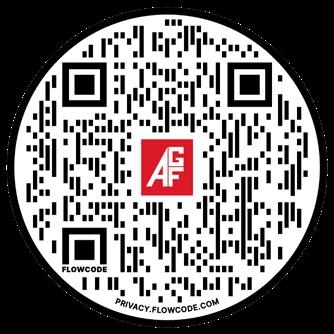
17 SPRINKLER AGE | MARCH/APRIL 2024
www.agfmfg.com
PRODUCT VIDEO
SMALL ADDITION BIG PROTECTION SMALL ADDITION BIG PROTECTION
THE NAC IS A “WIN-WIN”
NAC’S PHASE I EXAM HELPS EVALUATE, PREPARE, AND SHOWCASE YOUR APPRENTICES
D’ARCY MONTALVO | AMERICAN FIRE SPRINKLER ASSOCIATION
AFSA’s Annual National Apprentice Competition (NAC) is in its third decade of showcasing sprinkler fitter apprentices. While earning a spot in the Top 7 is the ultimate goal for apprentices, there are benefits to simply entering and taking the initial exam—Phase I of the competition. Apprentices can test their knowledge, learn areas they need to work on, and engage in a little friendly competition with their co-workers. As an added benefit, supervisors and employers can gauge apprentices’ progress, glean information to best mentor and support them, and help grow their confidence. AFSA Contractor members participating in the apprentice curriculum and the NAC recently shared their experiences with Sprinkler Age.
MARC HAUG, ALLIED FIRE PROTECTION
Marc Haug, S.E.T., president of Allied Fire Protection, Fargo, N.D., has been active with AFSA’s apprenticeship program since he acquired Allied in 2014. “We didn’t have a Department of Labor-registered apprenticeship program, so I spent quite a bit of time implementing AFSA’s program within our organization,” he remembers. “I wanted to create a program at Allied that helped us turn out qualified journeymen and ensure the installations they were doing were accurate and code-driven.”
It’s also advantageous because Allied can pay a percentage of the apprentice’s wage depending upon where they are in the program. “Additionally, when bidding on Davis-Bacon prevailing wage projects, we gain an advantage by being able to pay whatever percentage complete the apprentice is on the job. We just simply supply a copy of the certification from the Department of Labor,” comments Haug. “It gives us a more competitive edge.”
Haug’s passion for apprenticeship training led him to apply as a subject matter expert and instructor for AFSA’s Virtual Instruction Program for apprentices. “Not everyone is destined to go to a four-year college,” he says. “We’ve done a disservice to our young people not to encourage them to consider a trade.”
He continues, “With a trade, you’re trained and receive raises on the job, and, in the end, you’ve earned your journeyman’s card and incurred no debt! I don’t understand how we don’t have more people excited or interested in our trade. Being a VIP instructor reinforces my desire to teach people entering the trade and encourage them to grow and stay. I taught Level 1 last year, and
now I’m with a new group of Level 1 students, following along with the Level 2 group.”
Haug has been promoting AFSA’s NAC and encouraging his apprentices to take the Phase I exam for years. “It’s important for them to understand that taking the exam helps them understand how much they know or don’t know. It’s humbling for our apprentices but also a great motivator. It’s also a great precursor to the Minnesota State Fire Marshal’s exam, which apprentices must pass.”
Haug notes that the state exam has a 53-percent pass ratio for first-time apprentices who take the test. Allied has had three apprentices complete the AFSA curriculum and passed the state exam on their first attempt.
Now that AFSA offers the Phase I NAC exam online with a virtual proctor via the apprentices’ Canvas account, Haug says entering is a “no-brainer.” “There’s no reason not to take it! The competition test is similar to our state exam, and the test questions for both are derived from the NFPA code and NCCER books. “It’s a win-win for the apprentice and the contractor—it’s a good self-evaluation for the apprentices—and they just might advance to Phase II!”
Allied was excited to have its first apprentice advance to the finals in 2023, with Tim Farley competing at AFSA42: Convention, Exhibition, and Apprentice Competition in Orlando. “We’re very proud of Tim, and he had a great experience at the convention, which he shared with his colleagues.” Haug comments. “Being one of the top seven apprentices in the nation is a big achievement! They gain access to a pretty exclusive club at the end of the day.”
He continues, “It’s also a bragging right for our company. As an employer, we see validation that we’re doing the right thing for our guys and turning out quality sprinkler fitters into our industry.”
“Please, please, please consider sending your people. I don’t know if that can be stated enough,” Haug concludes. “Encourage your apprentices to compete, be prepared, and strive for excellence. The payoff for both employer and apprentice is well worth it.”
TAYLOR SCHUMACHER, SECURITY FIRE SPRINKLER
Security Fire Sprinkler, Sauk Rapids, Minn., has utilized AFSA’s apprenticeship curriculum since “the early days.” Project Manager Taylor Schumacher notes that AFSA’s program fits the state’s need for a registered apprentice program. While they knew the NAC, they never had an apprentice enter. “I think
18 SPRINKLER AGE | MARCH/APRIL 2024


what spurred us was that the Minnesota journeyman’s test is no cakewalk. We started to look at the NAC Phase I exam as practice for that test. Instead of asking an apprentice, ‘What topics are you comfortable with? What do you think you need to work on?’ we can look at the test results. The Phase I exam is point blank and helps the apprentice know exactly what to work on (i.e., standpipes).”
In 2022, Jacob Hanson was the company’s first apprentice to enter the competition. “I had to talk him into it!” Schumacher remembers with a laugh. “He wasn’t sure he’d do well, but I knew it’d be a good way to test his knowledge. As a business owner/manager, you go in the spirit of competition to help an individual excel, and it’s an opportunity to gain more experience.”
Schumacher has only seen benefits after Hanson’s experience at AFSA41 in Las Vegas. “First and foremost, being measured on a national stage boosted Jacob’s confidence level, and obviously, it shows a lot about his character, knowledge, and aptitude. The exposure to knowledge in seminars he attended and at the trade show just added to his bank. Winning the NAC is the American dream come true. It’s changing lives and shows that hard work truly pays off.”
Hanson has only excelled since competing—and winning—the 2022 NAC. He earned one of the highest state exam scores the company has seen and was able to pass the first time. He’s now a journeyman and running work.
Security enjoys the chance to showcase its employees. “It was a dream come true for us, too,” Schumacher remembers. “We told local newspapers about Jacob’s win and got local coverage. We sent out a notice to fellow contractors praising Jacob and got great feedback.” The company also has created a “Hall of Fame.” “It’s one way we show that we care about our employees and we care about training.”
Now that Security has had the NAC experience, the company plans to encourage apprentices to enter. “There’s nothing to lose, only things to gain,” he comments. “If you can inspire competition between your staff, it’s great. They’re trying to excel and to know more.”
“It’s very low stakes, and you never know what’ll happen!” concludes Schumacher. “Maybe, like us, your first-round entry will go all the way!”
COMPETITION DETAILS
Each year, the competition, created in 1994 by the late Robert L. McCullough, continues to attract apprentices from AFSA local chapters and member training programs from all corners of the United States. The Phase I exam must be taken between May 13 – June 30, 2024. Phase II of the competition occurs during AFSA’s annual convention and consists of two portions: a second written test and a live competition practical in the AFSA exhibition hall.
During the live competition, competitors construct and pressure-test a miniature sprinkler system in front of a packed exhibit hall. Each finalist is given a drawing of the system and all the required materials to install it. Finalists then construct the system with five sprinklers onto a 9-ft tall metal frame structure. Competitors must measure, cut, thread, and use fabricated materials for the installations per the drawing they are provided. This exercise requires pipe threading, math, and pipe make-up skills to complete the mini-system within the four-hour time limit. The CPVC section of the system is joined using one-step solvent cement. After the entire system is installed and allowed to set, it is placed under a static water pressure test of approximately 80 psi, with points deducted for any leaks or pressure drop. During the mini-installation, apprentices are judged in three areas—accuracy, craftsmanship, and safety—to form their practical score, which is combined with their written score to determine the winner.
TAKE YOUR APPRENTICES TO THE NEXT LEVEL
AFSA encourages all apprentices enrolled in its apprenticeship training program to participate. Besides an all-expenses-paid trip to Denver to compete at AFSA43, each finalist receives a commemorative plaque, tools, cash prizes, and a complimentary convention registration for their employer. To learn more, see page 42 of this issue or visit www.firesprinkler.org/competition/. n
19 SPRINKLER AGE | MARCH/APRIL 2024
From l to r: Marc Haug and Tim Farley had a “great experience” in Orlando during AFSA42 and the NAC.
From l to r: Taylor Schumacher, Calen Schumacher, Jacob Hanson,and Bob Schumacher celebrated at the AFSA41 Awards Party in Las Vegas.
HYDRAULICALLY CALCULATING STANDPIPE SYSTEMS
“IT’S SO EASY, A SPRINKLER-MAN CAN DO IT!”
KEVIN HALL, M.ENG, P.E., ET, CWBSP, PMSFPE | AMERICAN FIRE SPRINKLER ASSOCIATION
Hydraulic calculations for sprinkler systems typically boil down to three variables—flow, pressure, and K-factor. Friction loss in the piping network increases the total pressure required at each node and that increased pressure increases the flow from each flowing node based on the equation:
Q=K√P
Where:
Q is the flow in gpm
K is the K-factor of the sprinkler or branch line in gpm/psi1/2
P is the total pressure at the node in psi
In NFPA 14, Standard for the Installation of Standpipe and Hose Systems, the hydraulics are simpler. Standpipe systems do not consider balancing flows and K-factors of outlets. Since standpipe systems are manually operated by the fire department and trained personnel, the calculations only consider added flows as hose allowances. Whether there is 100 psi or 175 psi present at the outlet of the hose valve, the design is only going to include a 250-gpm flow from the fire department.
FLOW REQUIREMENTS
The total demand for a standpipe system is determined by flowing 250 gpm each from the two most remote hose connections of the hydraulically most remote standpipe (500 gpm total), then flowing another 250 gpm for each additional standpipe. The total system flow is capped off at 1,000 gpm for buildings sprinklered in accordance with NFPA 13, Standard for the Installation of Sprinkler Systems. Buildings sprinklered in accordance with NFPA 13R, Standard for the Installation of Sprinkler Systems in Low-Rise Residential Occupancies, partially sprinklered buildings, and non-sprinklered buildings are all treated the same in the eyes of NFPA 14 and raise the maximum flow rate to 1250 gpm. When including the flows for these additional standpipes, they do not have to be taken at the remote hose connections. Remember, standpipe systems are
calculated utilizing hose allowances, so the additional flows only need to be added at the point of connection of the standpipes to the common feed piping of the standpipe system.
There are a few special cases that deviate from the standard practice of determining the flow required from each standpipe system. For horizontal standpipes, if three or more hose connections are supplied, the initial flow needs to consider 250 gpm from three hose connections (750 gpm total). This increase in the initial flow from the most remote standpipe does not affect the maximum system flow, so the caps previously discussed are still valid. The other special case is when floor areas exceed 80,000 ft2. These large spaces do not increase the initial demand from the most remote standpipe but require 500 gpm instead of 250 gpm to be considered at the second standpipe, and 250 gpm to be considered at the third standpipe if one is present and if the building is not sprinklered in accordance with NFPA 13.
PRESSURE REQUIREMENTS
Standpipe systems require a minimum of 100 psi at the outlet of the hose connection. The term “outlet” used in the requirement is paramount when applying this requirement as the hydraulics need to consider the friction loss through the hose connection. It should be noted that while NFPA 14 does include a standard equivalent length for hose connections, the preferred and required value needs to come from the manufacturer’s datasheet. This issue was recently addressed in the 2024 revision cycle by including UL 668, Hose Valves for Fire Protection Service, as the referenced listing standard for hose valves, and the product standard was recently updated to include requirements for the manufacturers to publish friction loss data for their devices.
On the other side of the coin, the maximum pressure at any hose connection outlet is 175 psi, but there are suggestions in the annex that this can be exceeded where the fire department and their equipment are able to accommodate higher pressures. For system piping, where a hose connection is present, the pressure
20 SPRINKLER AGE | MARCH/APRIL 2024
needs to be limited to 400 psi, but where there is no hose connection (i.e., express risers), the pressure is essentially unlimited as long as all of the pipe, fittings, and devices are rated to handle that pressure.
In order to manage the duality of minimum and maximum pressures, pressure-regulating devices may be needed on the system. The design of these devices is worthy of its own article, so to oversimplify a complex subject, where installed, pressure-regulating devices are set based on the static pressure of the inlet, the residual pressure at the inlet at system demand, and the valve setting recommendations of the manufacturer. This requires the designer to perform a phantom calculation with no flow—in addition to the calculation at system demand—to determine the static pressure at each inlet so that the valves can be set appropriately.
CALCULATION PROCEDURE
One key distinction between sprinkler calculations and standpipe calculations is the termination point of the hydraulic calculation. Where the fire department connection (FDC) for sprinkler systems is only provided to provide supplemental pressure to the sprinkler system, standpipe system FDCs are sized to provide system demand. Both manual and automatic standpipe systems must be calculated back to the FDC inlet to verify that the fire department can supply the required flow and pressure to meet system demand. In addition to this requirement, automatic systems need to prove that the attached automatic water supply is also capable of supplying system demand. While this has been a requirement of NFPA 14 for several editions, how many designers actually provide both calculations when submitting their plans
CHAIR’S MESSAGE
The Site Selection Committee Chair, Jack Viola, P.E., announced the 2027 convention location will be in San Diego at the Hilton Bay Front. Great job and great location!
Our Legislative Committee Chair, Chris Johnson, and his committee are requesting nominees for the Fire Sprinkler Advocate of the Year Award. Visit www.firesprinkler.org/awards to nominate someone for this award. The committee is working on many issues around the country. Review Meda’s Q1 Board Committee Highlights email for a full review.
The Public Education & Awareness Chair, Brooks Bayne, reported their committee is working with AFSA contractors, headed up by Paulene Norwood, to install fire sprinkler systems in four Veterans’ homes with Homes For Our Troops. Thank you to our member companies and our manufacturers and suppliers for bringing this to fruition.
I mentioned earlier in my message it’s been a busy February with work and with celebrations. Congratulations to Mrs. Katie Meehan Woffard, who married Si on Feb. 3, 2024, in Richmond, Va., where we danced the night away. The next day she hopped on a plane and
and calculations to the Authority Having Jurisdiction (AHJ)? This means that every automatic standpipe system should be submitted with at least two standpipe calculations. More calculations would be necessary if there is more than one vertical standpipe system zone or more than one FDC on a system.
For a simple concept, standpipe systems can contain elaborate zoning arrangements and require multiple hydraulic calculations. The 2024 edition of NFPA 14 included substantial revisions to pressure and zoning requirements, and the savvy designer should review all of those changes. After your due diligence, feel free to submit your feedback, as the document is open for public input until June 1, 2024. For more information, go to www.nfpa.org/14next. n

ABOUT THE AUTHOR: Kevin Hall, M.Eng., P.E., ET, CWBSP, PMSFPE, is the senior manager of engineering and technical services for the American Fire Sprinkler Association (AFSA). He is a member of several National Fire Protection Association (NFPA) technical committees responsible for developing the model codes and standards, including, NFPA 1 Fire Code, NFPA 13/13R/13D Installation of Sprinkler Systems, NFPA 20 Installation of Stationary Fire Pumps for Fire Protection, NFPA 25 Inspection, Testing, and Maintenance of Water-Based Fire Protection Systems, and NFPA 200 Hanging, Bracing, and Anchorage of Water-Based Fire Protection Systems. He also represents AFSA on numerous UL technical committees responsible for revising and maintaining the product standards used in the sprinkler industry. He is a registered professional engineer in Delaware and Maryland, NICET III certified in water-based system layout, a certified waterbased system professional through NFPA, and a professional member of the Society of Fire Protection Engineers (SFPE). He earned his Bachelor of Science and Master of Engineering degrees from the University of Maryland College Park in fire protection engineering. In 2021, he was recognized as one of SFPE’s “5 Under 35” award recipients. Prior to his association and committee work, he worked for Reliance Fire Protection in Baltimore, Md., as a project manager overseeing projects of various sizes and complexity.
Continued from page 6
made it to the Board/Committee meetings in Ft. Lauderdale to chair the NextGen Committee. WOW! That is dedication to our industry and our membership. The committee requested and the Board approved to provide convention scholarships to encourage our next generation of leaders to participate at convention. The committee also voted and the Board approved to dedicate the Young Person of the Year Award to the committee’s founder and past chair, Joe Heinrich, renaming it to The Joe Heinrich Young Professional of the Year Award, a well-deserved honor.
Congratulations to our San Diego Executive Director, Rhonda Gudger! She wrote and published her first book “The Sprinkler Squad: The Adventures of the Fire Sprinkler Pals.” Please order your copy and support Rhonda for her part to educate our youth on how fire sprinklers save lives.
Now, as a mom, congratulations to my daughter, Emily. She got married on Feb. 24, 2024, to Johnny Wrenn in Dallas. It was an amazing weekend filled with love, laughter, and your daddy’s charm saying, “He would be here today if heaven wasn’t so far away.”
2024 is going to be a great year. Busy, but great! n
21 SPRINKLER AGE | MARCH/APRIL 2024
HFSC UNVEILS HOME FIRE SPRINKLER STUDIO
NEW ONLINE TOOL OFFERED TO BUILT FOR LIFE FIRE DEPARTMENTS
Increasing awareness about the need for installed home fire sprinklers can be very challenging for safety advocates. In every community, fire department personnel must juggle a serious response to chronic myths, spreading the facts about why unprotected home fires become deadly so quickly, and educating stakeholders about how home fire sprinklers work to save lives. It’s a big job. Fortunately, the Home Fire Sprinkler Coalition (HFSC) makes it easier.
HFSC brings local fire departments powerful grassroots support through its Built for Life Fire Department (BFLFD) program—at no cost to the departments. This spring, the program will feature the new HFSC Studio, an online tool fire departments can tailor to reach their audiences in a variety of ways. Funded through a grant from State Farm, the Studio makes it easy to customize flyers, posters and social media cards. The Studio will be featured during Home Fire Sprinkler Week, May 12-18, 2024.
More than 3,600 fire departments have joined the program, pledging to educate locally about home fire sprinklers to achieve community risk reduction goals. Their tactics are diverse, ranging from community outreach and participation in Home Fire Sprinkler Week every May to utilizing HFSC’s model home-developer sprinkler incentive program to supporting local code upgrades to preventing fire sprinklers from being omitted from codes.
HFSC’s relationship with BFLFD departments is collaborative. HFSC offers exclusive opportunities, like valuable stipends to support grassroots programs and community outreach. Only BFLFDs are eligible to apply for these stipends. Qualifying departments must complete applications clearly stating how the stipend will be used and commit to completing a comprehensive evaluation of their stipend program. The stipends can be used to build a home fire sprinkler riser display, purchase VR headsets so audiences can view HFSC’s virtual reality video, customize educational banner stands, conduct live fire and sprinkler demonstrations, display TV monitors to showcase HFSC educational videos and more. Since 2010, HFSC has awarded fire departments more than $425,000 in home fire sprinkler educational stipends.
HOME FIRE SPRINKLER DISPLAY KIT
The Home Fire Sprinkler Display Kit contains instructions
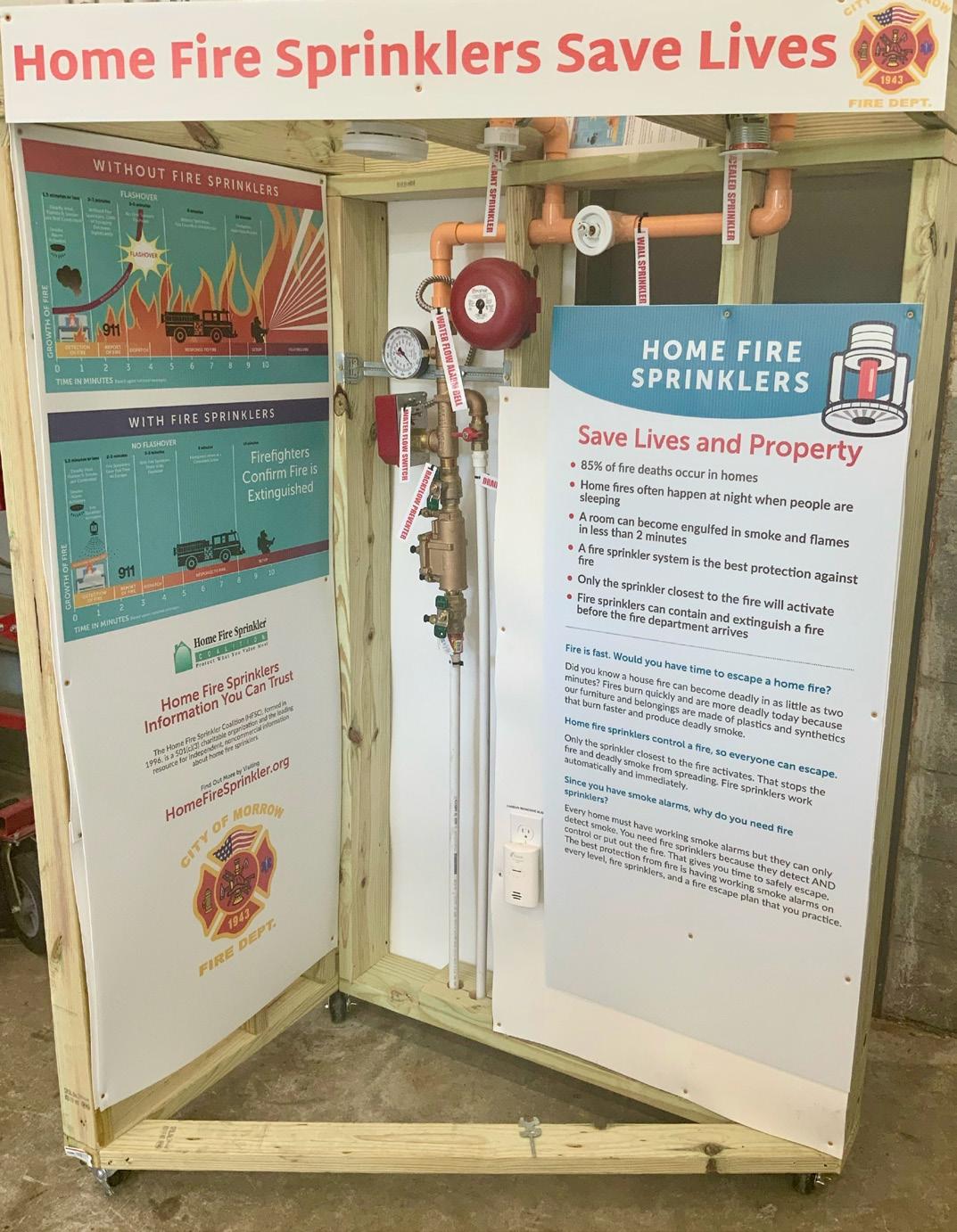
for building a portable display that shows the inner workings of an NFPA 13D, Standard for the Installation of Sprinkler Systems in One- and Two-Family Dwellings and Manufactured Homes, home fire sprinkler system and various sprinkler options. It can be customized to match local system requirements. The display can be constructed by personnel with moderate to good carpentry skills. Riser installation should only be done by a qualified home fire sprinkler installer.
The display is portable, and it works with a wide range of audiences and many types of events. Here are some examples: community events, school activities, homebuilder partnerships, and
22 SPRINKLER AGE | MARCH/APRIL 2024
BFLFDs can use HFSC’s Home Fire Sprinkler Display Kit to customize the home fire sprinkler display to match the requirements in their jurisdiction.
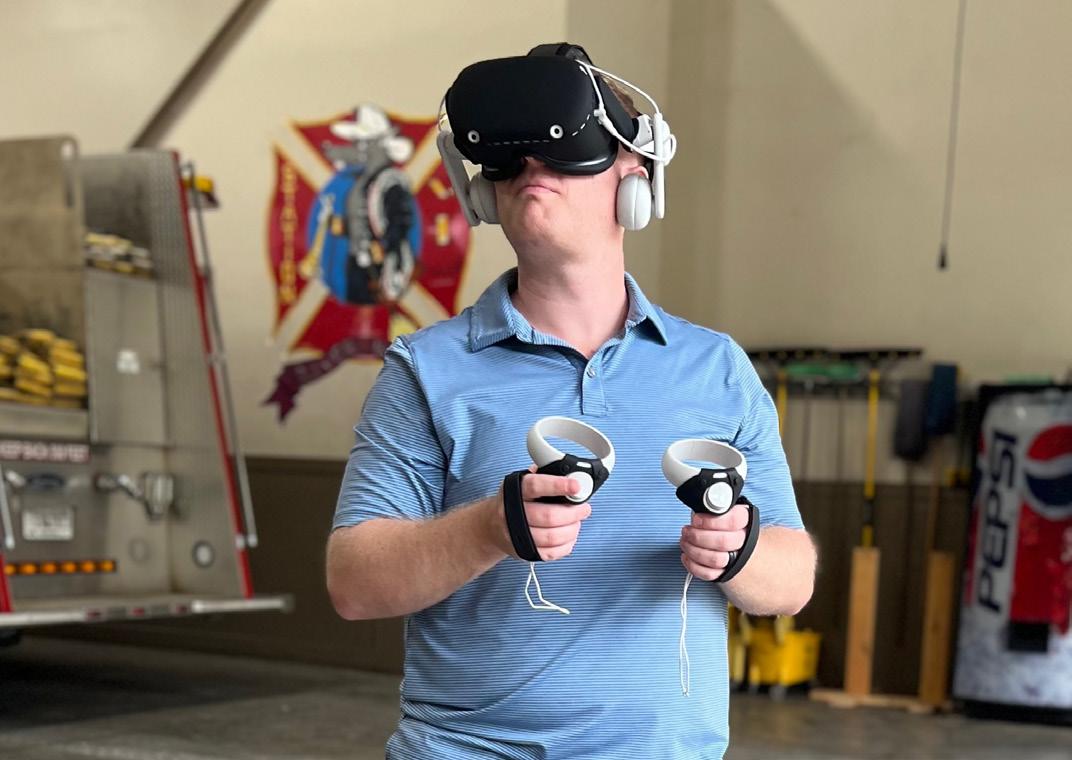
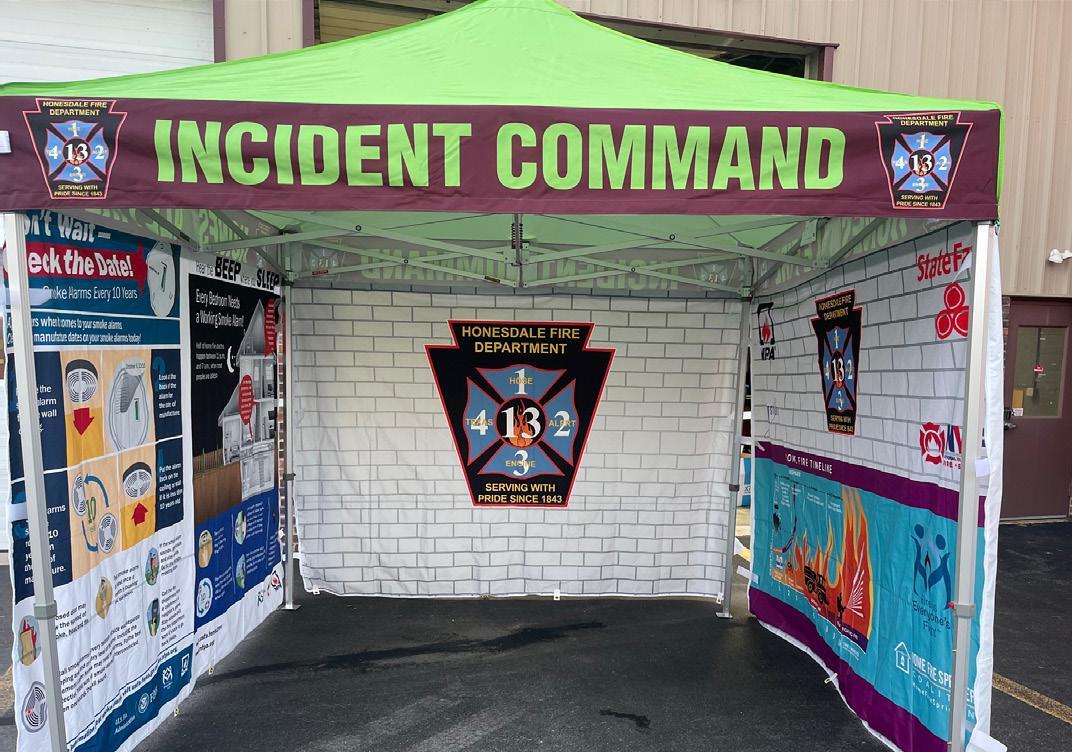
municipal activities. Use the display to educate other professionals at their offices and meetings: insurance agents, real estate agents, and water suppliers. Share your display with other fire departments near your jurisdiction when they have public education opportunities. Development of this kit was funded through a grant from State Farm. HFSC thanks AGF Manufacturing and the Northern Illinois Fire Sprinkler Advisory Board for technical assistance.
WIN-WIN PARTNERSHIP
BFLFDs play an important role in return for the benefits. They aid HFSC’s creative process by providing feedback ahead of development and before we release new educational resources, giving HFSC the opportunity to refine, target and improve its
national outreach. Their stipend program evaluations and other completed surveys help HFSC understand local home fire sprinkler challenges as well as success stories. As an example of this partnership, BFLFDs have been trying out the new HFSC Studio so it will meet the needs of all kinds of departments when HFSC launches it. HFSC expects the Studio to be a widely used resource. Eighty-nine percent of surveyed BFLFDs said they would be interested in an online tool where they could customize messages.
The full list of BFLFDs can be viewed online at https:// homefiresprinkler.org/fire-department-members/. Fire departments interested in applying for the program can visit HFSC’s website, https://homefiresprinkler.org/fire-department-application/. n

23 SPRINKLER AGE | MARCH/APRIL 2024
The BFLFD in Newton County , Ga. purchased HFSC’s VR headset to use at an open house event.
The BFLFD in Honesdale, Penn. used funds to create an informational pop-up tent.
HFSC’s Studio helps BFLFDs customize flyers, posters, and social media cards to help educate the public about residential fire sprinklers.
HELP AFSA HELP YOU
SPRINKLER FITTER APPRENTICESHIP PROGRAMS
BOB CAPUTO, CFPS | AMERICAN FIRE SPRINKLER ASSOCIATION
We all know the weakest link in the chain of success for this industry is a lack of qualified and trained people. In fact, I recently had a member tell me that they have such a hard time finding people to hire, they now encourage long-haired, freaky people to apply. Yes, there are members who could grow at a faster pace with better funding or working capital, but, at its core, the Achilles heel for most AFSA members continues to be qualified field labor and well-trained layout technicians. I’m sure many of you are tired of hearing (or reading) me beat this drum. What many of you may not know is that I am a drummer, and as such, you get the picture.
AFSA has expanded many training programs, especially for sprinkler fitting apprentices, with our Virtual Instruction Program (VIP). This program is designed to allow employers to focus on the OJT (field training) part while AFSA delivers the classroom portion in the hope of creating better pathways for success in terms of training and retention to benefit the employers and employees. (AFSA is always looking for additional qualified trainers.)
Our fitter apprenticeship program has always experienced some drop-off candidates, especially following book one, based on some deciding being a fitter isn’t a good fit for them (pun intended) or perhaps better opportunities came along. Regardless, with good hiring practices up front followed by a sincere interest shown by employers who encourage and reward progress and retention, we should see better results in
this area… we are not. So where are the problems, and what are the solutions?
Let’s start with the concerns I’ve shared many times related to hunters and gatherers versus farmers as it applies to developing people for our industry. Some companies invest in training programs for long-term gains (farmers), while others often pick off the fruits of their labor before that fruit has had time to ripen (hunters and gatherers). In plain English, those companies with short-term vision hire (poach), undertrain people, and offer higher-than-deserved pay rates to solve their short-term, immediate need to get a job done. I think we all understand why this happens, but in the bigger picture, that practice is hurting our industry, and I urge those who practice this to reconsider the sustainability of it.
Under-trained and overpaid workers are increasing your liability and holding your entire company back in terms of long-range growth and profitability. Investing in training people for longterm productivity and sustained knowledge will help you drive success. In addition, ask yourself, as leaders, managers, or business owners, where you came from. How did you start in this industry, and what were the building blocks to your success? We all know fire sprinkler company owners who started as fitters or designers/technicians. Who trained, mentored, and invested in you?
Let’s consider the fact that many companies do not take advantage of formal training programs like AFSA’s sprinkler fitter apprentice programs, inspector training and development, or our design schools. In fact, there are a lot of open shop fire sprinkler contractors across the United States who don’t
belong to AFSA, NFPA, or any trade association. Let’s set that group aside for now and focus the conversation on the people I care about the most… our AFSA members. How can we help make our members stronger and better in the long term?
I believe having a formal apprenticeship program for the sprinkler fitting trade is critical to success, especially for merit shop contractors. There is a lot more to installing a fire sprinkler system than just twisting pipe or using an impact driver to make up the bolts on grooved couplings. There is a reason apprentices and certification programs are subjected to 6,000 plus OJT manhours, and balancing hourly labor costs to install systems is not among them. It takes time to learn any trade and to be exposed to enough circumstances and experiences to develop the skills necessary to be called a journeyman or journeywoman.
We are in a constant battle with organized labor and with our own federal government to be considered as equals for government contract awards and accredited programs. When we choose to opt out of real training programs approved by the Department of Labor (DOL), we open ourselves up to the criticisms leveled by groups who would like to see us outlawed, banned, and banished from major projects and government-funded work—projects funded by your tax dollars. To expedite the DOL registration process for our members, AFSA has registered our sprinkler fitting curriculum as National Guideline Standards (NGS) with the DOL. This essentially gets your apprenticeship program halfway to the DOL-
24 SPRINKLER AGE | MARCH/APRIL 2024
registered finish line. You, as the employer, can work with your local DOL representative to fill in the blanks (on items like wages, reporting, hiring, etc.) to take your application the rest of the way resulting in a federally registered apprenticeship program.
Like any program, our new VIP classroom training has had a few people fall behind in their expected progress, including exams. The program anticipated this and provided a contingency by extending opportunities by up to two months for apprentices who need a little extra time to complete each phase of training. However, even with a built-in extension opportunity, we still have a few enrolled apprentices who drop out or, worse, end the formal training but stay on working in the field without proper training.
The solution must start with the employer. Encouraging registered apprentices to stay on course while providing rewards for milestone successes as well as penalties for falling behind or dropping out is the best and simplest pathway to success. These practices will also encourage others to want to get into formal apprenticeship programs. We want to encourage our contractor members to exercise good hiring practices to ensure higher success rates, but we all need to invest in best-in-class training for the strength and longevity of our industry and the merit shop movement.
We are in this together! Your AFSA is here to deliver robust training programs for your company’s benefit and long-term health. We need your help to ensure these programs are delivered at the level where they matter most, with your people at the local level. We rely on employers, leaders, and managers to keep your people engaged and on track in enrolled training programs because we here at AFSA do not have any control over them to ensure they stay on track. We are in this together, but we cannot do it alone. Help us help you by taking an active role in ensuring your investment in the people you enroll in AFSA training programs meets
their intended outcomes so you, they, and we all enjoy the results and successes we expect. n
ABOUT THE AUTHOR: Bob Caputo, president of AFSA, is chair of the NFPA 24 and NFPA 291 Technical Committees and a member of multiple NFPA technical committees, including NFPA 13 and NFPA 25. Caputo is a contributor of the NFPA 13 and NFPA 25 Handbooks, the Fire Protection Handbook 21st edition, and the NFPA Inspection Manual. He has written and presented seminars throughout the world on fire protection and life safety systems, project and field labor management, and is a regular speaker at AFSA and NFPA conventions. Caputo is an instructor at the National Fire Academy and a member of the Industry Advisory Board at OSU School of Fire Protection Engineering & Safety. His industry distinctions include “Fire Prevention Officer
of the Year ‘’ from San Diego County in 1994; “Man of the Year” from Fire Protection Contractor magazine in 1997; and the Henry S. Parmelee award from AFSA in 2017. Caputo attended the University of Albuquerque, New Mexico and is a U.S. Navy veteran and former volunteer firefighter.







25 SPRINKLER AGE | MARCH/APRIL 2024
www.fayettepipe.com 2282 University Drive Lemont Furnace, PA 15456 724.438.7600 sales@fayettepipe.com AFFORDABLE. AVAILABLE. RELIABLE. In Stock and Ready to Ship American Made & Melted Sch 10 and Sch 40 Quality hydrotested ERW Sch 10 and Sch 40 A795/A135 Type E Grade A black steel pipe for new construction and retrofit fire sprinkler systems 10’, 10’ 6” and 21’ lengths available Save up to 7% per ton with TBE vs. T&C UL listed and FM approved Shipped anywhere in the continental US
about our Sch 40
Sch
Nipples: Carbon
Galvanized, and Zinc-Plated
Ask
and
80
Welded,
RECOGNIZING APPRENTICE EXCELLENCE
ANNOUNCING THE 2023 NATIONAL APPRENTICE HONOR ROLL
The American Fire Sprinkler Association’s (AFSA) National Apprentice Honor Roll was first established in 2012 to recognize those trainees, along with their sponsoring employers, who have completed all four levels of the AFSA Fire Sprinkler Fitting apprenticeship training series with a cumulative grade point average of 95 percent or above. Inductees into the 2023 class represent approximately the top 8 percent of the 192 four-level graduates for the year. The following companies are the proud employers of inductees into the 2023 National Apprentice Honor Roll:
• Berkshire Systems, Reading, Penn.;
• Dartmouth Fire Protection, Dartmouth, Mass.;
• Encore Fire Protection, Pawtucket, R.I.;
• Metropolitan Fire Protection, Broomall, Penn;
• Midwestern Mechanical, Sioux Falls, S.D.;
• New England Fire Systems, Inc, Bellingham, Mass.;
• Phoenix Fire Protection, Idaho Falls, Idaho;
• Professional Fire Systems, Southborough, Mass.;
• Severson Fire Protection, Bend, Ore.;
• VSC Fire & Security, Cabot, Ark.;
• Xcel Fire Protection, Salem, N.H; and
• Xtreme Fire Protection, Sioux Falls, S.D.
“This group of apprentices and their employers is an excellent representation of quality apprenticeship instruction,” states Leslie Clounts, AFSA director of education services. “Intentional commitment from both apprentice and employer is needed for successful apprenticeship.”
Recognition plaques for the students are provided to the sponsoring employer so that the contractor company can present the plaque at an appropriate time and location. AFSA is pleased to honor the contractors who participate in this training curriculum and encourage their fitter trainees to study and do well on their tests by recognizing these companies in Sprinkler Age .
APPRENTICESHIP OPPORTUNITIES
The National Apprentice Honor Roll is one way AFSA acknowledges the hard work and commitment of both apprentices and employers enrolled in the association’s apprenticeship training series.

AFSA’s Sprinkler Fitting book(s) are produced through a partnership between AFSA and the National Center for Construction Education and Research (NCCER). In 2023, the books were updated to correlate with NFPA 13, Standard for the Installation of Sprinkler Systems, 2019 edition.
Last year, AFSA also unveiled its new virtual instruction program (VIP) for the apprentice curriculum. Each level provides 10 months of education to accompany the On-the-Job Learning (OJL) conducted by the employer. VIP includes the updated textbooks, two live sessions each month, performance tasks to reinforce the modules, self-study components, and assessments. The live lessons are instructed by AFSA staff and subject matter experts (SMEs). Let AFSA handle the related technical instruction (RTI) portion, so you can focus on apprentices’ field training. For more details about the AFSA’s apprentice training packages and to register, visit firesprinkler.org/sprinkler-apprentice-training/.
Another way to recognize apprentices is to encourage them to compete in the National Apprentice Competition (NAC). Phase 1 testing is easier than ever with online testing through each apprentice’s Canvas account. Then cheer on this year’s finalists at AFSA43: Convention, Exhibition, and Apprentice Competition, September 18-21 in Denver, Colo. For details on AFSA43 see page 12 of this issue or visit www.firesprinkler.org/ AFSA43. For information on the NAC, see page 42 of this issue or visit www.firesprinkler.org/competition. n
26 SPRINKLER AGE | MARCH/APRIL 2024
AFSA’s updated Sprinkler Fitting curriculum and VIP program help apprentices learn and excel.
Metal Face Storz FDC Connections
F.D.C. Quick Connections




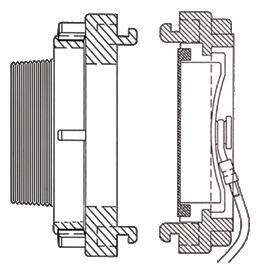

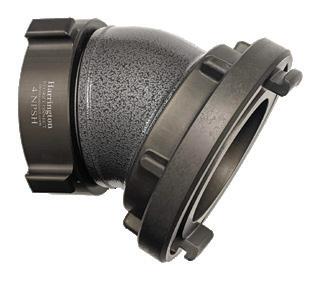



Description
30° Elbow, NPT Female Rigid
x Storz: Threads onto NPT Male Pipe Thread
30° Elbow, NPSH Female Swivel x Storz: Threads onto NPT Male Pipe Thread
Stand Pipe Wall Mount
30° Elbow, NPT Male Rigid
x Storz: Threads into NPT Female Pipe Thread
Straight, NPT Female Rigid x Storz: Threads onto NPT Male Pipe Thread. NEW Low Profile models
Straight, NPT Male x Storz: Threads into NPT Female Pipe Thread
FDC Storz now available with Metal Face: Harrington introduces innovative FDC Storz adapters featuring an exclusive Metal Face Storz design, eliminating the gasket & locking device – both areas of avoidable failures. In addition, this unique design ensures a more secure and tamper-resistant Storz Cap, preventing the introduction of foreign debris into the line. This enhancement is a valuable addition for your customers, aiding in the prevention of firefighting system clogs. Our product range includes both straight and elbow configurations, tailored to meet the diverse needs of your customers. All Storz heads are forged and anodized for extended durability, and elbows undergo an anodization process followed by powder coating for a high-quality finish. Proudly manufactured in the USA!
Don’t settle for inferior imports that contain lead- choose Harrington, Inc. for all your water handling needs.

MAKE ALL YOUR CONNECTIONS BIG & FAST: Harrington has a complete line of Hydrant and Sprinkler Storz, unmatched by anyone, anywhere.
West 21st Street, Erie, PA 16506 • 800.553.0078 • info@harrinc.com • hydrantstorz.com
2630
Intermediate ITM Workshop

3 DAYS HANDS-ON TRAINING

Course Overview
Participants will explore the intricacies of NFPA 25, gaining practical expertise in determining the minimum frequencies and procedures for inspection and testing. They will also perform water flow tests on private service mains and standpipes and analyze and interpret the results.
Course Objectives
Identify the operation and required NFPA 25 periodic inspection, testing, and maintenance requirements for private fire service mains, deluge, and preaction systems.
Execute a water flow test of private fire service mains and standpipes, collect data, and analyze the results.
Discover troubleshooting techniques for common system issues and the requirements for 3 and 5-year testing.
Upcoming Classes
Jul. 10 - 12 Aug. 21 - 23 Nov. 13 - 15
more at www.firesprinkler.org/ITMworkshop
Learn

NEED A HAND WITH CALCULATIONS?
WORKSHOPS PROVIDE IN-DEPTH TRAINING
nderstanding hydraulic calculations is vital when designing fire protection systems. While there are computer programs available, designers need to understand the basics and how these calculations are derived. The American Fire Sprinkler Association (AFSA) offers two workshops to understand and apply the principles of hydraulics. These classes provide in-depth education and hands-on exercises to ensure designers return to the workplace with the knowledge and skills they need to design effective and efficient systems. Both of these classes are geared toward helping the attendee pass a hydraulics certification exam as required by some certification agencies.
SPRINKLER HYDRAULIC CALCULATIONS
In this three-day, in-person workshop, students will understand and apply principles of hydraulics, including the different types of







pressure, calculating changes in pressure (elevation and friction loss), and node analysis. This course will be offered in May 2024 and provides 2.25 CEUs, 22.5 NICET CPDs, and 22.5 CEUs Florida Approved Credits. For more information and to register for this class, visit www.firesprinkler.org/programs/calculations/.
ADVANCED SPRINKLER HYDRAULIC CALCULATIONS
This three-day, in-person workshop provides a deep dive into advanced hydraulic principles for standpipe systems, fire pump assemblies, and water storage tanks. Students will receive classroom instruction, work through examples, and complete practice exercises. This course will be offered in July 2024 and provides 2.25 CEUs, 22.5 NICET CPDs, and 22.5 CEUs
Florida Approved Credits. Visit www.firesprinkler.org/ programs/advanced-sprinkler-hydraulic-calculations-workshop/ for more details and to register. n
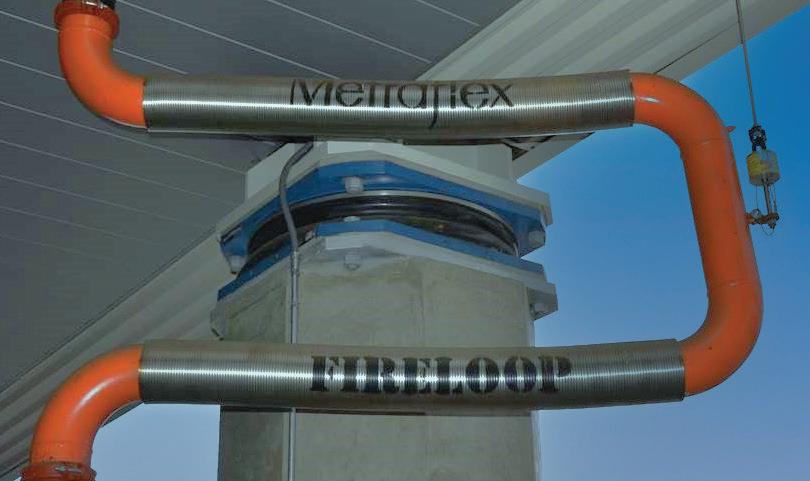



Trusted, Proven Protection for Fire Sprinkler Systems.
The Fireloop® expansion U-Loop® is a highly flexible joint with 360-degree movement, with sizes able to accommodate movements up to ±45 inches. It meets NFPA13 guidelines, is UL listed, and FM Approved.
Install with the Seismic Breakaway Hanger, an engineered release mechanism, to ensure full-rated movement.
©












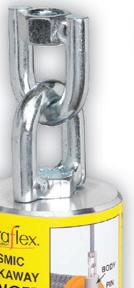






29 SPRINKLER AGE | MARCH/APRIL 2024
2024 The Metraflex Company
TOP-NOTCH TRAINING FOR ITM TECHNICIANS
AFSA OFFERS COMPREHENSIVE PROGRAMS TO TAKE INSPECTORS TO THE NEXT LEVEL
The American Fire Sprinkler Association’s (AFSA) has taken inspection, testing, and maintenance (ITM) training to a new level with its ITM Inspector Development program and three ITM training courses tailored to each level of inspector. Expand your business and increase your employees’ knowedge and skill set with these training opportunities in 2024.
ITM INSPECTOR DEVELOPMENT PROGRAM
AFSA’s Inspection, Testing, and Maintenance (ITM) Inspector Development program is designed to help participants pass NICET Level I and II water-based inspection and certification exams in less than two years. Program graduates achieve a 93 percent pass rate on NICET Level I and II exams, exceeding the 60-percent national average.
“Our ITM Inspector Development Program produces a well-trained inspector,” comments AFSA Director of Education Services Leslie Clounts. “AFSA was the first to offer a blended-learning format with on-demand lessons, webinars, and inperson training that delivers results.”
The training course is combined with a robustly structured on-the-job training (OJT) and mentoring program with the goal for candidates to pass NICET Level I and II water-based inspection certification exams in less than two years. Through this 20-month program, created to develop a beginning technician into a NICET Level II-equivalent inspector, AFSA delivers a blended learning environment to include:
• Fifty-six hours of on-demand courses;

• Twenty-one hours of live, interactive web instruction;
• Live in-class lectures;
• Hands-on field and lab inspections and testing training;
• Limited class size maximizing student learning outcomes;
• A guided and systematic process for the “green” inspector trainee toward NICET I and NICET II certifications;
• Encouraging and fostering characterbuilding traits: honesty, integrity, confidence, professionalism, neat appearance, organization, reliability, accountability, and credibility; and
• Strengthening communication skills, both written (for noting inspection and testing observations) and verbal (communicating with customers). Pairing this program with proper OJT and supervision will position contractors to educate a new inspector
in-house and prepare him or her to help grow your company.
No prior experience is needed to enroll. Register now for the Fall 2024 session, which begins in October, before it sells out! Visit www.firesprinkler.org/programs/ sprinkler-inspector-training-program.
NEW ITM WORKSHOPS
AFSA has developed new training courses specifically for ITM. These courses target all experience levels of technicians, inspectors, Authorities Having Jurisdictions (AHJs), and facility managers. In the new Beginning ITM Workshop, students will become an expert on essential procedures and best practices for proper functioning and reliability of sprinkler systems based on NFPA 25, Standard for the Inspection, Testing, and Maintenance of Water-Based Fire Protection Systems. This workshop will provide further knowledge on codes and standards and all
30 SPRINKLER AGE | MARCH/APRIL 2024
AFSA’s ITM students read pitot pressure during a flow test.
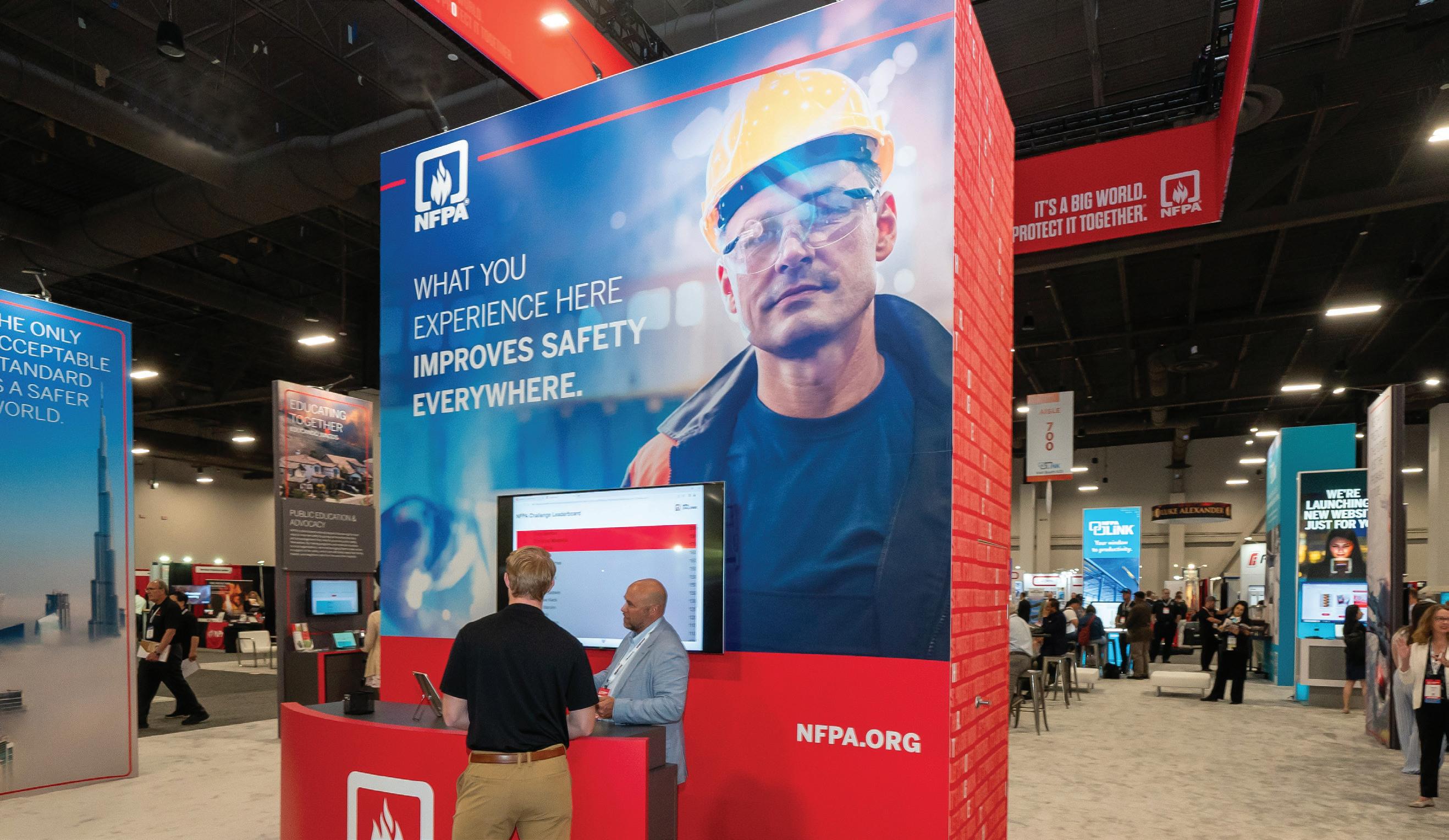
WHO: NFPA Conference & Expo® features a wide variety of more than 350 exhibitors and 120+ educational sessions, workshops, and presentations for anyone involved in safety. Attendees include fire protection engineers, electricians, firefighters, building and facility managers, manufacturers of safety equipment, government officials, and all other safety professionals.
WHEN: Conference & Expo: June 17–19, Technical Meeting: June 20–21
WHERE: Orange County Convention Center, Orlando, Florida
WHY: Collaborate and network with thousands of your colleagues, experts from several industries, and NFPA staff on life, fire, and electrical safety innovation.
HOW: Choose your level of access at nfpa.org/conference2024

ORLANDO IMPROVES
EVERYWHERE. SAVE THE DATE FOR NFPA CONFERENCE & EXPO® 2024. ORANGE COUNTY CONVENTION CENTER | ORLANDO, FL CONFERENCE & EXPO JUNE 17 –19 | TECHNICAL MEETING JUNE 20 – 21 LEARN MORE nfpa.org/conference2024 800-344-3555
WHAT HAPPENS IN
SAFETY
HERE YOUR NEXT TOP DESIGNER

DESIGN SCHOOL Intermediate DESIGN SCHOOL Beginning
Re-designed for a hybrid approach, with six live webinars offered first, followed by one week of in-person instruction. Students will study the installation & design approach requirements of NFPA 13 (2019), prepare system layout drawings, and perform hydraulic calculations by hand.
April 2 -26
July 15 -26
Experienced layout technicians will find this blended learning course useful to understand the tools they utilize in-depth and gain a deeper knowledge of layouts for standpipe systems, fire pumps, seismic protection, and the design requirements for general storage.
July 22 - Aug. 2
Nov. 5 - 15 (IN PERSON)
Oct. 28 -Nov. 22
WWW.FIRESPRINKLER.ORG/NEXTLEVEL
WWW.FIRESPRINKLER.ORG/DESIGN
STARTS
parties involved in inspections and testing. In this training, participants will detect potential issues, conduct inspections and tests, complete routine maintenance tasks, and compare components of various water-based fire protection systems. Upon course completion, 16 CPDs, 1.6 CEUs, and 16 contact hours are earned.
The intermediate-level ITM students will perform water flow tests on service mains and standpipes, collect and analyze results, and perfect participants’ knowledge in determining frequencies and procedures for inspection and testing. This training explores advanced topics such as component differentiation, sequence of operations, and specific considerations for deluge and preaction systems. Individuals will gain a deeper understanding of inspection, testing, and maintenance procedures through certification test-taking strategies, in-depth knowledge of 3- and 5-year ITM, and hands-on troubleshooting exercises. This course awards 24 CPDs, 2.4 CEUs, and 24 contact hours.
Develop knowledge of fire pump installations and essential ITM processes in the Fire Pump ITM Workshop. This

workshop will discuss key differences between diesel- and electric-driven fire pumps and present various water flow tests. AFSA provides hands-on performances of no-flow and full-flow fire pump tests and educates on ITM requirements for water storage tanks. Participants also interact with energy diffuser selection, data acquisition, supply graphing, and data
interpretation to provide an understanding of stationary fire pumps. Participants earn 16 CPDs, 1.6 CEUs, and 16 contact hours once they’ve completed this course.
INVEST IN YOUR EMPLOYEES
Learn more details about all ITM training online at www.firesprinkler.org or email training@firesprinkler.org. n

33 SPRINKLER AGE | MARCH/APRIL 2024 Need Backflow Repair Parts? BAVCO IS YOUR SOLUTION! West Coast - Long Beach, CA (800) 458-3492 • info@bavco.com Central - San Antonio, TX (866) 318-0274 • txinfo@bavco.com East Coast - Charlotte, NC (844) 202-1618 • ncinfo@bavco.com Your Complete Source for Backflow Parts & Accessories www.bavco.com • Complete Inventory • Product Knowledge • Same Day Shipping • In Stock When You Need It
Hands-on training includes capturing the discharge pressure of a fire pump during an annual flow test.
AFSA’s Technical Advisory Council (TAC) will hold its inaugural meeting on March 19 and 20 at AFSA’s headquarters in Dallas. The TAC will discuss upcoming changes to NFPA standards, including possible NITMAMs for NFPA 13, Standard for the Installation of Sprinkler Systems, and NFPA 20, Standard for the Installation of Stationary Pumps for Fire Protection; proposed PCs for NFPA 25, Standard for the Inspection, Testing, and Maintenance of Water-Based Fire Protection Systems, and NFPA 200, Standard for Hanging and Bracing of Fire Suppression Systems; and proposed PIs for NFPA 14, Standard for Installation of Standpipe and Hose Systems. In light of the upcoming TAC meeting, it seems appropriate for this column to decode the alphabet soup, which is the NFPA standards development process.
PUBLIC INPUT STAGE
When a document enters the public input stage, the entire document is open for proposals. These proposals to change the document are called public inputs (PIs). Anyone can submit a public input—you don’t even have to be an NFPA member! When making a PI, the submitter should provide exact language for the applicable technical committee to consider, as well as a technical substantiation for the change. The benefit of submitting a PI is that the technical committees are required to respond to every PI during the first draft meeting. During this meeting, the technical committee can either create a first revision (FR) based on your PI or resolve your PI with a committee statement. For the first draft, a motion to resolve is a polite way of rejecting a proposal while still providing feedback to the submitter so they can try again during the public comment stage. Once the first draft meeting is finished, the committee will officially vote on all of the first revisions, and those that receive two-thirds affirmative votes will be published in the first draft report. Those first revisions that do not achieve two-thirds affirmative votes on the ballot will be downgraded to committee inputs (CIs) and published in a separate report. It should be noted that the committee can create its own CIs during the first draft meeting, and these items are essentially trial balloons that the committee is seeking further comment from the public before making an actual change to the document.
PUBLIC COMMENT STAGE
Once the first draft report is posted, interested parties should review all of the actions and be able to provide additional proposals or public comments (PCs) during the public comment stage. The first half of the public comment stage mirrors the public input stage, except that only items that were addressed during the public input stage can be changed. This means that the PC has to be related to a PI, CI, or FR. If there is no related item from the public input stage, then the committee will typically reject your proposal and hold it until the next revision cycle. For the PCs that have related items, the committees are required to respond to each one. During the second draft meeting, PCs can either be “accepted” or “rejected.” Accepted PCs will be made into second revisions (SRs) using the submitter’s
language verbatim, while rejected PCs can be rejected outright with another committee statement or rejected with a related SR where the committee essentially accepted the proposal in principle but made some changes to the proposed text. Once the second draft meeting is finished, the committee will officially vote on all of the SRs, and those that receive two-thirds affirmative votes will be published in the second draft report. Those SRs that do not achieve two-thirds affirmative votes on the ballot will be downgraded to committee comments (CCs) and published in a separate report.
There is an extra part in the public comment stage where the public is able to submit a notice of intent to make an amending motion (NITMAM). This is the final opportunity for the public to submit changes, but the allowed actions are limited. This is why NITMAMs must be submitted to and reviewed by the NFPA Standards Council to be certified as an amending motion (CAM). CAMs are then published and debated on the floor at the NFPA Technical Meeting. The most common NITMAMs and CAMs are to accept a PC—this motion can only be made by the submitter of the PC—and to reject an SR—this motion can be made by anyone.
NFPA TECHNICAL MEETING
The NFPA Technical Meeting closes out the NFPA Conference & Expo® each year. It is at this meeting that all of the CAMs are debated, and the entire NFPA membership is able to vote on whether they support or oppose the CAM. Successful CAMs are sent back to the appropriate technical committee to either accept the recommendation of the NFPA membership or revert the affected sections to the previous edition’s text—this is the last point of consensus. The next issue of Sprinkler Age will include a voting guide for all of the CAMs that will be debated at the 2024 NFPA Conference & Expo® in Orlando.
COUNCIL APPEALS AND ISSUANCE OF STANDARD
While appeals can be submitted, they are rarely upheld and typically only consider procedural issues during the revision cycle that an individual protests. After the dust has settled from the technical meeting and all CAMs and appeals have been resolved, the Standards Council will put their final stamp of approval and issue the next edition of the document.
If you would like to get involved with AFSA’s TAC or the NFPA standards development process, reach out to AFSA’s engineering and technical services department at technical@firesprinkler.org. n


34 SPRINKLER AGE | MARCH/APRIL 2024 3 2 HIGHER STANDARDS KEVIN HALL, M.ENG, P.E., ET, CWBSP, PMSFPE AFSA SENIOR MANAGER OF ENGINEERING & TECHNICAL SERVICES
TECHNICAL CHALLENGES
CAN YOU MEET THE CHALLENGE?
AFSA’s Engineering & Technical Services Department staff present technical challenges here for you and your co-workers. These exercises are also excellent preparation for professional certification tests and may count as CEUs. Check with your certification organization. Answers to this issue’s questions will be presented in the next issue.
JANUARY/FEBRUARY ANSWERS
The following questions are based on NFPA 25, 2023 edition.
1. How often are diesel fuel tank level float switches and supervisory signals for the interstitial space (area between the double tank walls) required to be tested for liquid intrusion? 8.1.1.2.7 Fuel tanks, float switches, and supervisory signals for interstitial space shall be tested quarterly for liquid intrusion.
A. Monthly B. Quarterly
C. Semi-annually D. Annually
2. How often must you change the oil filter on a diesel engine driver?
8.1.1.2.18 Lubricating oil filters shall be changed every 50 hours of operation or annually.
A. Every 50 hours of operation
B. Quarterly
C. Semi-annually
D. Annually or every 50 hours of operation, whichever comes first
3. What is/are the criteria to determine acceptable performance during an annual test of a fire pump assembly? 8.3.7.1.1 The interpretation of the net flow test performance relative to the manufacturer’s original performance shall be the basis for determining acceptable performance of the pump assembly.
8.3.7.1.1.1 The interpretation of the gross flow test performance relative to acceptably meeting the demands of all connected fire protection systems shall be the basis for determining acceptable performance of the pump assembly and connected water supply.
A. The interpretation of the net flow test performance relative to the manufacturer’s original performance data
B. The interpretation of the gross flow test performance relative to acceptably meeting the demands of all connected fire protection systems
C. Both A and B
4. On a fire pump system utilizing a flow meter for testing, how often and to what accuracy level are flow meters required to be calibrated?
8.3.3.5.3* Flow meters shall be calibrated annually to an accuracy level of ±3%.
A. Annually, +/- 1% B. Annually, +/- 3%
C. Every three years, +/- 1% D. Every three years, +/- 3%
MARCH/APRIL QUESTIONS
The following questions are based on NFPA 13, 2022 edition.
1. Given a wet sprinkler system with a 10-ft length of 21/2-in. schedule 10 black steel piping with two grooved elbows in the pipe, what is the equivalent length for this pipe for hydraulic purposes? (Assume the elbows have an equivalent length per their listing of 4.3 ft of schedule 40 black steel pipe, C =120.)
A. 10.0 feet
B. 14.3 feet
C. 18.6 feet
D. 21.8 feet
2. Given a dry sprinkler system with a 10-ft length of 3-in. schedule 10 galvanized steel piping with two grooved elbows in the pipe, what is the equivalent length for this pipe for hydraulic purposes? The air supply for this dry sprinkler system is an air compressor. (Assume the elbows have an equivalent length per their listing of 5 ft of schedule 40 black steel pipe, C =120.)
A. 10.0 feet
B. 19.6 feet
C. 20.0 feet
D. 23.4 feet
3. Given a dry sprinkler system with a 50-ft length of 2-in. schedule 40 black steel piping with two threaded cast iron elbows in the pipe, what is the equivalent length for this pipe for hydraulic purposes?
A. 50.0 feet
B. 57.1 feet
C. 60.0 feet
D. 70.4 feet
4. A 2-in. wet sprinkler system riser contains a control valve, check valve, vane-type water flow switch, and a test and drain assembly. What equipment needs to be included in the hydraulic loss for the hydraulic calculation?
A. Control valve, check valve, water flow switch, and test and drain assembly
B. Control valve, check valve, and water flow switch
C. Control valve and check valve
D. Control valve, check valve, and test and drain assembly
5. A 10-ft piece of 11/2-in. schedule 40 black steel pipe has a threaded cast iron 11/2-in. x 11/4-in. reducing elbow on the end. For hydraulic calculations, what size fitting is used to determine the equivalent length?
A. 11/4 in.
B. 11/2 in.
C. 13/4 in.
D. 2 in.
35 SPRINKLER AGE | MARCH/APRIL 2024 2
#MEMBERSMATTER!
What is the best definition of success? The best definition of success can vary greatly depending on individual perspectives and goals. For some, success may be synonymous with financial stability or professional achievements, while for others, it may involve having a fulfilling personal life or making a positive impact on the world. Whatever definition resonates with you, success in the fire sprinkler industry is a four-letter word, A-F-S-A!
AFSA serves as the leading organization for training in the fire sprinkler industry. Success in the industry begins with cultivating a skilled workforce. Well-trained employees decrease a company’s liability and minimize the potential for costly mistakes that could lead to property loss or, more critically, loss of lives. It ensures that employees have the necessary skills and knowledge to provide quality work, adhere to regulations, and minimize the potential for accidents and injuries.
Trained employees are retained employees and find value in the company that employs them. Employees desire incentives that will improve performance, making training an essential strategy for retaining top performers. Better work culture and low turnover are just a few advantages of training. Well-trained employees are more engaged, motivated, and aligned with organizational goals, resulting in improved productivity and higher profits. Investing in employee training ensures that they possess the necessary skills and knowledge to deliver quality work, comply with regulations, and mitigate accidents and injuries. Moreover, trained employees are more likely to feel valued by their employer, leading to higher retention rates and a stronger organizational culture and preventing the loss of tenured knowledge and skills.
AFSA offers a comprehensive training program that spans from apprenticeship to advanced certification, providing a clear path for professional development within the industry. By partnering with AFSA for training needs, companies can differentiate themselves from competitors, deliver superior service to customers, and achieve financial stability through repeat business and recurring revenue. What company doesn’t want financial stability? By leveraging AFSA’s training programs, companies can ensure that their employees are wellequipped to excel in their roles. This improves the quality of work and enhances customer satisfaction and loyalty, leading to repeat business and sustained growth.
AFSA partnerships with key industry companies play a crucial role in helping businesses save time and money by reducing overhead costs. These partnerships often involve negotiated discounts and special offers on essential services and products that your company regularly utilizes.
For example, AFSA manufacturers and suppliers may offer discounted rates to AFSA contractor members. This can result in significant savings for your company, which needs to purchase items regularly for projects. Additionally, AFSA may partner with service providers such as insurance companies or 401(k) consultants, which helps lower insurance coverage premiums or plan rates. AFSA’s partnerships extend beyond discounts on equipment, materials, or insurance. They also encompass savings on various project management, time tracking, and payment processing tools. Project management tools like busybusy help companies plan, organize, and execute their projects efficiently, ensuring deadlines are met, and resources are utilized effectively. Time-tracking tools are valuable for accurately recording employees’ hours worked on different projects, which are essential to payroll processing and project costing. Payment processing tools like Service First Processing enable companies to accept customer payments quickly and securely, improving cash flow. AFSA can help you access reliable payment solutions at competitive rates, saving you money on transaction fees and processing costs.
By facilitating these partnerships, AFSA not only helps its members save money but also streamlines the procurement process by providing access to trusted vendors and service providers. This allows the company to focus its resources on core business activities, ultimately improving efficiency and profitability.
Partnering with AFSA for all your training needs and business expenses can be a strategic move toward achieving success in the fire sprinkler industry. AFSA offers comprehensive training programs and valuable partnerships that help businesses enhance the skills of their workforce, reduce overhead costs, and improve overall competitiveness.
Partnering with AFSA aligns businesses with a trusted and reputable organization dedicated to advancing excellence in the fire sprinkler industry. Together, businesses and AFSA can work towards achieving greatness. Success begins with A-F-S-A! n

36 SPRINKLER AGE | MARCH/APRIL 2024
MEDA MERRITT
SENIOR DIRECTOR OF MEMBERSHIP & CHAPTER DEVELOPMENT
AFSA
AFSA NEW MEMBERS
New members as of March 3, 2024
CONTRACTORS
Avalanche Fire Protection, Co., Dinuba, CA
Aztek Fire Safety, LLC, Baton Rouge, LA
Base Line Fire Protection Inc., Downey, CA
Double D Piping Fire Protection, Cleveland, TN
Epic Systems Group, Burlington, NJ
Family Fire Protection Inc., Plympton, MA
Place Services, Inc., Easley, SC
S&H Fire Services LLC, Westminster, MD
Service Fire & Industrial, Inc., Forney, TX
Soluciones De Fluidos, S.A., Panama
WC Fire Protection Inc., Tustin, CA
FACILITY MANAGERS
James Chitty, Dallas, TX
Henry Putnam, South Portland, ME
Steven Redden, Middletown, DE
AHJS
Nick Abatiell, Rutland, VT
Jeffrey Abts, Menasha, WI
Nathan Adler, Lake Havasu City, AZ
Jeffrey Almond, Lincoln, RI
Sam An, London, ON
Dwaynne Ardeneaux, Baton Rouge, LA
Moses Barbosa, Fort Lauderdale, FL
Kaley Bartlett, Yuba City, CA
James Bashore, College Park, MD
Preston Bentley, Denver, CO
Zayn Berggren, New Orleans, LA
Chris Bickings, Birdsboro, PA
Cary Blanchard, Plantation, FL
Southern Bokkes, Temecula, CA
Danny Brown, Merced, CA
Jacob Burgess, Centennial, CO
Heidi Caldwell, Ventura, CA
Teresa Caparrelli, Naples, FL
Martin Casillas, Las Vegas, NV
Mindy Cavallari, Fort Lauderdale, FL
Michael Chabot, N. Attleboro, MA
Kevin Chastain, Greenville, SC
John Colpo, Georgetown, DE
Brandy Cox, Troy, AL
Jacob Crow, Baton Rouge, LA
Scott Ctvrtnik, Naples, FL
Sean Culleton, Overland, MO
Paul Dansereau, Bennington, VT
Steve Dawald, Los Alamos, NM
Araseli del Castillo, Lodi, CA
Letisha Desmares, New Orleans, LA
Paba Dhanaseela, Georgetown, ON
Vicente Diaz, Covina, CA
Thomas Dimmerling, Phoenixville, PA
Mike Doucet, Baton Rouge, LA
Michelle Douglas, Running Springs, CA
Carla Dufort, Sedona, AZ
Andrea Eanes, Kingston Springs, TN
Scott Eckstein, Richardson, TX
Dave Ehmiller, Minneapolis, MN
Kevin Embrey, Bethesda, MD
Ian Enright, Riverside, CA
Tony Eoppolo, New Castle, DE
Corey Eppinghaus, Collingwood, ON
Stan Fernandez, San Rafael, CA
Dale Fey, Jr., Naples, FL
Thomas Flanagan, Egg Harbor Twp, NJ
Ryan Flora, Westfield, IN
Richard Foster, Toms River, NJ
Michael Fridie, Tucker, GA
Will Friedericks, New Palestine, IN
Thomas Galliford, Bethel, CT
Axel Garcia, Pflugerville, TX
Jeannette (Jena) Garcia, Monrovia, CA
Debra Gardner, Philadelphia, PA
Jim Gery, Boulder, CO
Jesse Gianino, Centennial, CO
Ryan Gillaspy, Phoenix, AZ
Brad Gleason, Centennial, CO
Rich Goddard, Gallatin, TN
Danilo Goyochea, Fort Lauderdale, FL
Adam Graves, Centennial, CO
Steven Gray, Tulare, CA
Joshua Hall, Yuba City, CA
Jeffry Hanenberg, Colorado Springs, CO
Brian Hanrahan, Minneapolis, MN
James Hartnett, Manassas, VA
Douglas Holland, Port Carling, ON, Canada
Steven Hughes, Warwick, RI
Neil Hutzol, Las Vegas, NV
Ashley Inserra, Davie, FL
Kelly Intzes, St. Pete Beach, FL
Doug Iwanicki, Springfield, IL
Kyle Jackson, Columbia, SC
Matt Jakubowski, N. Clarendon, VT
John Jeng, Frisco, TX
Oray A. Johnson, Baton Rouge, LA
Christopher Jones, Urbana, OH
Roderic Jones, Baton Rouge, LA
Aimee Jordan, Bradford, ON, Canada
Timothy, Kalmar, Uniontown, OH
Jake Karales, Arlington Heights, IL
Anwar Kassas, Hamilton, Ontario
William Kelly, Georgetown, DE
Jane Kim, Fairfax, VA
Ericka Kircher, Centennial, CO
Joseph Kvacik, Salina, KS
John Lane, Denton, MD
Steve Lennon, Fort Myers, FL
Ryan Leonardo, Tulare, CA
Davin Lindsay, Oakville, ON, Canada
Brian LoMonaco, Los Angeles, CA
Gilbert Louis, Colorado Springs, NM
Langston Malin, Fairfax, VA
Rodney Marvel, Georgetown, DE
David Mason, Tucker, GA
Tyson Matyas, Las Vegas, NV
Desiree McCall, Georgetown, DE
Scott McCormick, Hamilton, NJ
Kenneth E McDuffie, Jr, Wauchula, FL
Daniel McKenzie, Charlotte, NC
Kyle McMurrian, Bixby, OK
Alicia Merritt, Coral Springs, FL
Michael Messer, Springfield, VT
Guy Miglinas, Ridgefield, CT
Jackielou Mozes, Fort Myers, FL
Rosalee Naples, Naples, FL
Charles Nicol, London, ON
James Nolan, Enfield, CT
Daniel Noonan, Keyport, NJ
Scott Oswald, Inver Grove Hts, MN
Erik Owen, Enola, PA
Bob Patterson, Cary, NC
Ryan Payne, Canton, GA
Todd Perez, Baton Rouge, LA
Nicole Pesqueira, Brea, CA
Roland Peterson, Colorado Springs, CO
Boyd Petty, Baton Rouge, LA
Timothy Pittman, Wheaton, MD
Mary Pizzadili, New Castle, DE
Mike Politio, Baton Rouge, LA
Michael Priest, Canton, GA
Tony Pruitt, Tucker, GA
Jackie Purviance, Bainbridge Isl., WA
Sammy Purvis, Thomson, GA
David Ravelo, Long Beach, CA
Robert Rewis, Ft Myers, FL
Malak Rezek, Hamilton, ON, Canada
Sal Ricitelli, Springfield, VT
Kirk Riddell, Sedona, AZ
Gillian Robinson, Hamilton, ON, Canada
Anthony Rocco, Ft. Lauderdale, FL
Joe Rukavina, Centennial, CO
Brian Russell, Sedona, AZ
Ryan Schartel, Philadelphia, PA
Matthew Schneider, Charleston, SC
Kate Schramm, Barrie, ON
Randy Scovill, Redondo Beach, CA
Michael Semelsberger, Gaithersburg, MD
Philip Shaver, Freeland, MI
Christopher Shaw, Goose Creek, SC
Dylan Sickler, Centennial, CO
Prachi Singh, Sugarland, TX
Kristin Smallwood, Fort Lauderdale, FL
Karen Snyder, Fort Myers, FL
Melissa Souza, Sarasota, FL
Robert Sprenkle, Centennial, CO
Mike Starke, Colorado Springs, CO
Gamal Stewart, Plantation, FL
Zachary Stillwell, Tamarac, FL
Jennifer Strom, Ft Lauderdale, FL
Tim Sullivan, Centennial, CO
Bill Svozil, Dixon, CA
April Turner, Stockbridge, GA
Eric Urban, Renton, WA
Mike Vadlja, Orillia, ON, Canada
Carlos Vega, Salinas, CA
Shane Vesce, East Rockaway, NY
Prakash VG, Hamilton, ON, Canada
Heidi Vinduska, Centennial, CO
Tyler Vinet, New Orleans, LA
Vanessa Visco, Barrie, ON, Canada
Stephen Walton, Charlottesville, VA
Mei Wang, Halton Hills, ON, Canada
37 SPRINKLER AGE | MARCH/APRIL 2024
AFSA NEWS
CALENDAR
MAY 2024 10
• Introduction to the Fire Sprinkler Industry AFSA Headquarters, Richardson, TX https://www.firesprinkler.org/calendarevent/ introduction-to-the-fire-sprinkler-industry-2/
20 - 22
• Sprinkler Hydraulic Calculations Workshop AFSA Headquarters, Richardson, TX https://www.firesprinkler.org/calendarevent/sprinklerhydraulic-calculations-workshop-7/
JULY 2024
10 - 12
• Advanced Hydraulic Calculations Workshop AFSA Headquarters, Richardson, TX
https://www.firesprinkler.org/calendarevent/advancedhydraulic-calculations-workshop-5/
15 - 26
• Beginning Design School - In Person AFSA Headquarters, Richardson, TX https://www.firesprinkler.org/calendarevent/beginningdesign-school-in-person/
22 - Aug. 2
• Intermediate Design School AFSA Headquarters, Richardson, TX https://www.firesprinkler.org/calendarevent/ intermediate-design-school-2/
SEPTEMBER 2024
4
• Introduction to the Fire Sprinkler Industry AFSA Headquarters, Richardson, TX https://www.firesprinkler.org/calendarevent/ introduction-to-the-fire-sprinkler-industry-2/ 18-21
• AFSA43: Convention, Exhibition, and Apprentice Competition Denver, CO https://www.firesprinkler.org/AFSA43/
OCTOBER 2024
14 - 25
• Intermediate Design School AFSA Headquarters, Richardson, TX https://www.firesprinkler.org/calendarevent/ intermediate-design-school-2/
JALYN HOPKINS JOINS THE TEAM
The American Fire Sprinkler Association (AFSA) is pleased to welcome Jalyn Hopkins as its apprenticeship training programs coordinator. Hopkins is the main point of contact for all things related to AFSA’s Virtual Instruction Program (VIP). She crafts course schedules and produces online Canvas courses for students. Hopkins also keeps record of student successes and progress by keeping track of records, grades, and attendance. She also attends each live session and provides extra support for the instructors.
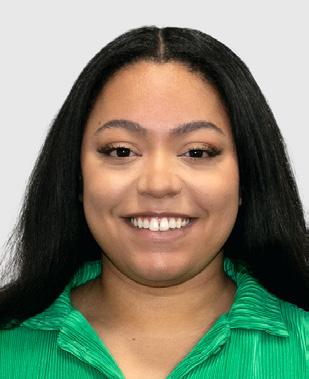
Quality training and education are essential for AFSA. As the industry continues to look to AFSA for training, members in the education department are vital to the organization. Hopkins helps the team and dedicates her full attention and efforts to students. In this position, she offers apprentices a more in-depth learning experience, ensuring they receive answers to their questions, support, and details about their progress. Hopkins builds rapport with the students in the program, ensuring they have a certain level of comfort as they navigate from Level 1 to Level 4.
“As the VIP courses are growing, AFSA needed to bring on support to assist in administering them,” says AFSA’s Director of Engineering & Technical Services, Victoria B. Valentine, P.E., FSFPE. “Jalyn has joined our team and brings enthusiasm, organization, and dedication to providing quality virtual education to industry apprentices. It’s exciting to have someone onboard who fit rapidly into the team and is already helping to improve the program’s efficiency.”
SCHOLARSHIPS FOR COLLEGE STUDENTS
Through August 31, 2024, eligible college or trade school students can visit afsascholarship.org to apply for one of AFSA’s “second chance” scholarships. Created by AFSA’s Public Education & Awareness Committee to raise awareness about fire sprinklers, the fire protection industry, and its careers, the contest is open to those students who want to pursue a college degree or trade school education. The scholarship offers the chance to win one of five scholarships. Applicants visit the website, read a short passage on fire protection and fire sprinklers, and answer questions about the reading. Each correct answer offers one entry into the scholarship contest, with eight entries possible per applicant! Five winners are randomly selected to receive a one-time $1,000 AFSA scholarship payable to their respective college, university, or trade school. For more details and to enter, visit afsascholarship.org/secondchance/.
STAY IN THE KNOW WITH SPRINKLER AGE
Sign up to receive your own free copy of Sprinkler Age magazine— print, digital, or both! Qualified industry professionals can sign up for a free subscription online at sprinklerage.com/subscribe. For more information or to view the digital edition, visit sprinklerage.com. n
38 SPRINKLER AGE | MARCH/APRIL 2024
subject to change. Call (214) 349-5965 to confirm locations and times. For more events and details, visit firesprinkler.org and click on “Events” and “Events List.”
Seminars
HOPKINS
CHAPTER NEWS

LOUISIANA
AFSA’s Louisiana Chapter, the Louisiana Fire Sprinkler Association (LFSA), hosted an all-day training event presented by AFSA Vice President of Technical Services & Engineering John Denhardt, P.E., FSFPE. Topics of discussion included inspections, fire pumps, and standpipes. AFSA President Bob Caputo, CFPS, hosted the first session to a room full of attendees. AFSA’s Board Chair, Linda Biernacki was also in attendance.
The next seminar and membership meeting will be held Tuesday, April 23, 2024. For more information, visit www.lafiresprinkler.org.
SCHUYLKILL
AFSA, ASCET, NFSA, and SFPE gathered at Hotel West & Main in Conshohocken, Pa., on Jan. 8. The associations discussed their big plans for 2024 and enjoyed dinner and cocktails. Sarina Rose from ABC discussed potential upcoming projects in the local area working alongside the Schuylkill Chapter. NFSA’s Shane Ray announced the governor of New Jersey has signed a bill making sprinklers in multifamily housing law. This is a big victory for the industry and the state of New Jersey!
The chapter also hosted a two-day seminar event at Hotel West & Main in Conshohocken from Feb. 28 - 29. Each seminar provided CEUs or credit hours that may be used towards certification renewals. The training event offered networking opportunities, new product news and updates, and breakfast and lunch. Visit www.afsapendel.org/.
VIRGINIA
The Virginia Chapter’s next member meeting will be held April 4, 2024, at Four Points by Sheraton in Richmond. Past AFSA Chair of the Board and Region 6 Director Michael Meehan with VSC will present, “Observations From Pipe Fitter to C Suite to Industry Future.” Rhodes Consulting will be the vendor for this event and Ed Rhodes
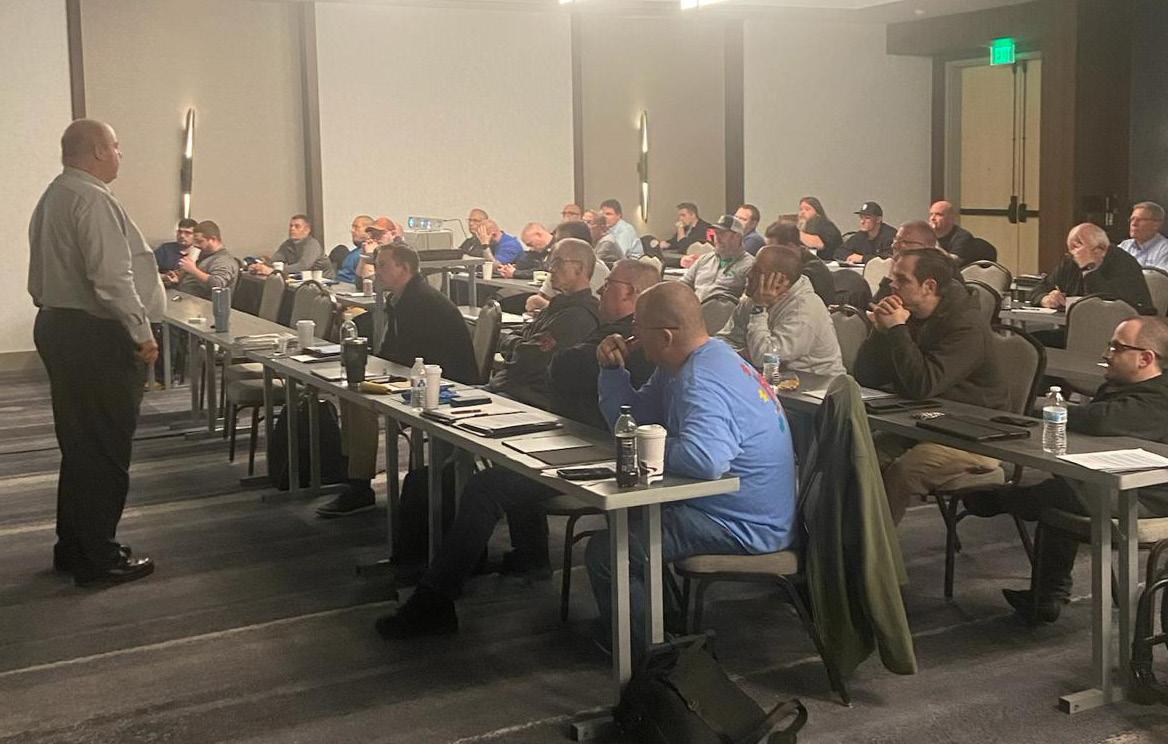
will present “Find out what a Lobbiest does for AFSA.” For details, visit https://virginiaafsa.org/. n
ASSOCIATION NEWS
FSCATX
The Fire Sprinkler Contractors Association of Texas (FSCATX) 2024 Scholarship applications are open. The winner will be awarded $2,000 for this year’s fall semester. Submit your application by June 1, and the board of directors will elect a winner by July 1. All fire protection industry applicants will receive priority. Visit fscatx.org/ scholarship for more details on this opportunity.
FSCATX will host several training days in April on “NFPA 25 and Hydraulic Calculations,” presented by AFSA Vice President of Technical Services & Engineering John Denhardt, P.E., FSFPE. Attendees can earn up to 8 CEUs in one day. On April 8, the training day will be in Houston at the Cadillac Bar; on April 9, in Austin at the Frank Fickett Center—Heritage Room, and in the DFW area on April 11 at the Construction Educational Foundation Building at DFW Airport.
FSCATX’s 2nd Quarter Chapter Luncheons will be held on these dates in the following locations: May 21: DFW meeting at the Winewood Grill in Grapevine, May 22: Houston meeting at the Cadillac Bar in Houston, and May 23: Austin meeting at the Frank Fickett Center—Heritage Room in Austin.
Skins and Fins 2024 will be held June 6-9 at the South Shore Harbour Resort in League City with the theme “Wild West Adventure.” Registration is now open! For more details, visit https://fscatx.org/. n
39 SPRINKLER AGE | MARCH/APRIL 2024
1
3 2
AFSA’s John Denhardt, P.E., FSFPE, speaking at the AFSA Schuylkill Chapter Training Event.
AFSA President Bob Caputo, CFPS, presenting during the morning session of the LFSA event.
AFSA CHAPTERS
ALABAMA
Lee Seewald – Pres.
202-252-5101
Greg Willis – Exec. Dir. 334-567-4257
ARIZONA
Jason Williams – Chair
480-421-8411
Denniece Cooper - Exec. Dir. 480-282-5393
ARKANSAS
Dennis Morrall – Chair
901-734-4796
Coleman Farrar – Exec. Dir. 479-461-3863
CHESAPEAKE BAY
Jason Martin – Chair 410-286-3314
Danielle Fowler – Exec. Dir. 410-972-1122
COLORADO
Roger Wallace – Chair 719-337-6550
Kim Cook – Exec. Dir. 704-213-4368
DALLASFORT WORTH
CJ Bonczyk – Chair 817-529-1693
FLORIDA
Bob DiModica - Chair
239-514-7155
Jessica Cox – Exec. Dir. 813-784-3624
GEORGIA
Allen Cagle – Chair 770-554-5285
Tracy Williams – Exec. Dir. 770-355-0774
GREATER BAY AREA
Dave Karrick – Chair 925-417-5550
Alicia Karrick – Exec. Dir. 510-398-9185
GREATER KANSAS CITY
Mark McKenzie – Chair 913-432-6688
Brett Heinrich – Exec. Dir. 785-825-7710
ILLINOIS-INDIANA
Skyler Bilbo – Chair
217-342-2242
Mitch Bortner – Vice Chair 206-348-0078
LOUISIANA
Randy Laguna – Chair
504-464-6236 ext 224
Ellen Ballard – Exec. Dir. 318-688-8800
MICHIGAN
Doug Irvine, Jr. – Chair 616-784-1644
MINNESOTADAKOTAS
Marc Huag – Chair 701-232-7008
Tina Hoff – Exec. Dir. 701-709-1899
NEW ENGLAND
Lisa DiRienzo – Chair
508-298-2134
Cheryl Tsetsilas – Exec. Dir. 603-890-3331
AFSA AFFILIATE MEMBERS
OKLAHOMA AFFILIATE
ofsa.info
Tim Hollon – Pres. 918-851-2416
NEW JERSEY
Thomas Bowlby, Jr. – Chair
908-226-5313
Victor Lugo – Exec. Dir. 201-635-0400
NEW MEXICO
Paul Chavez – Chair
505-898-9197
Jeriod Towery – Vice Chair 505-410-4007
NORTH CAROLINA
Jason Graham – Chair 919-533-2356
John Turnage – Exec. Dir. 919-624-3456
OHIO
Scott Huber – Exec. Dir. 513-942-1500
PACIFIC
NORTHWEST
Chris Russell – Chair
360-734-4940
Ron Greenman – Exec. Dir. 253-576-9700
SACRAMENTO VALLEY
Jordan Hopkins – Chair
Paulene Norwood – Exec. Dir. 916-296-0635
SAN DIEGO
Mark Scott – Chair 619-778-2377
Rhonda Gudger – Exec. Dir. 951-326-4600
SCHUYLKILL
Christopher Campion, Jr. – Chair 732-798-0911
Meaghen Wills – Exec. Dir. 610-754-7836
SOUTH CAROLINA
Tyler Blume – Chair 864-909-2643
Ashley McAdams – Exec. Dir. 864-561-4088
SOUTHERN CALIFORNIA
Vahe Zohrabian – Exec. Dir., Treasurer 818-822-1797
TENNESSEE
Casey Milhorn – Chair
615-349-5278
David Pulliam– Exec. Dir. 901-484-0605
UTAH ROCKY MOUNTAIN
Mark Winder, Jr. – Chair
385-630-8064
Brent Heiner – Exec. Dir. 801-544-0363
VIRGINIA
Bob Beckwith – Chair
540-659-4675
Steve McGee – Exec. Dir. 757-544-0520
TEXAS AFFILIATE fscatx.org
David Stone – Pres. 713-466-9898
Sarah Kiefer – Exec. Dir. 512-844-6632

40 SPRINKLER AGE | MARCH/APRIL 2024
U.S. CONSTRUCTION REPORTS
CONSTRUCTION STARTS GROW 20% IN DECEMBER
Total construction starts grew 20% in December to a seasonally adjusted annual rate of $1.12 trillion, according to Dodge Construction Network. Nonresidential building starts rose 37% during the month, while residential starts gained 8% and nonbuilding starts improved by 13%.
For the full year of 2023, total construction starts lost 4% compared to the previous year. Residential and nonresidential starts were down 13% and 8%, respectively, but nonbuilding starts were up 16%.
“Construction starts ended the year on a positive note,” said Richard Branch, chief economist for Dodge Construction Network. “Looking ahead, the new year provides promise that positive momentum will continue to build. The planning queue is stabilizing, and the promise of lower rates should spur construction onward. While hurdles remain, including scarce labor and tight credit, 2024 should be a more positive year for the construction sector.” n
CONSTRUCTION STARTS GROW 1% IN JANUARY
Total construction starts grew 1% in January to a seasonally adjusted annual rate of $1.16 trillion, according to Dodge Construction Network. Nonbuilding starts rose 9% during the month, while nonresidential building starts fell 2% and residential starts were flat.
For the 12 months ending January 2024, total construction starts were down 1% from the 12 months ending January 2023. Nonresidential building starts were down 5% while residential starts were 8% lower, with nonbuilding starts up 17% on a 12 month rolling sum basis.
“Construction starts are struggling to make headway in the new year,” said Richard Branch, chief economist for Dodge Construction Network. “Construction starts will continue to struggle early on in 2024 as higher interest rates and tight credit standards are slowing down projects moving through the planning cycle to start. The Federal Reserve is expected to cut rates later this year. That will move some of these projects in the planning queue through to start and provide for a more stable rising trend in construction activity in the second half of the year.” n
MONTHLY SUMMARY OF CONSTRUCTION CONTRACT VALUE
MONTHLY SUMMARY OF CONSTRUCTION CONTRACT VALUE
December
41 SPRINKLER AGE | MARCH/APRIL 2024
Prepared by Dodge Data & Analytics MONTHLY CONSTRUCTION STARTS Millions of Dollars, Seasonally Adjusted Annual Rate Dec 2023 Nov 2023 % Change Nonresidential Building $ 479,227 $ 350,116 37 Residential Building $ 390,908 $ 362,594 8 Nonbuilding Construction $ 253,019 $ 223,766 13 Total Construction $ 1,123,154 $ 936,477 20 THE DODGE INDEX (2000=100, Seasonally Adjusted)
2023......................238
2023.................198 YEAR-TO-DATE CONSTRUCTION STARTS Unadjusted Totals, in Millions of Dollars 2023 2022 % Change Nonresidential Building $ 411,252 $ 445,160 -8 Residential Building $ 365,065 $ 417,587 -13 Nonbuilding Construction $ 297,184 $ 256,589 -16 Total Construction $ 1,073,501 $ 1,119,336 -4
November
Prepared by Dodge Data & Analytics MONTHLY CONSTRUCTION STARTS Millions of Dollars, Seasonally Adjusted Annual Rate Jan 2024 Dec 2023 % Change Nonresidential Building $ 483,326 $ 490,811 -2 Residential Building $ 393,209 $ 391,839 0 Nonbuilding Construction $ 279,520 $ 256,839 9 Total Construction $ 1,156,056 $1,139,489 1 THE DODGE INDEX (2000=100, Seasonally Adjusted) YEAR-TO-DATE CONSTRUCTION STARTS Unadjusted Totals, in Millions of Dollars 1 Mos. 2024 1 Mos. 2023 % Change Nonresidential Building $ 38,600 $ 27,529 40 Residential Building $ 31,636 $ 23,255 36 Nonbuilding Construction $ 22,268 $ 18,871 18 Total Construction $ 92,504 $ 69,656 33
APPRENTICES ENTER TO WIN
UP TO $5,000 CASH A SET OF NEW HAND TOOLS AN EXPENSE-PAID TRIP FOR YOU AND A GUEST
Seven national finalists will receive an expense-paid trip to compete at AFSA’s National Convention, Exhibition and Apprentice Competition in Denver, Colorado, and a complimentary convention registration for a guest (to be determined by their employer), plus tools, and cash prizes. Employers may enter as many qualifying apprentices as you want! There is no cost to enter the competition.








more details visit www.firesprinkler.org/competition
For
PEOPLE IN THE NEWS
FPRF ANNOUNCES THREE NEW TRUSTEES
The Fire Protection Research Foundation (FPRF or Foundation), the research affiliate of the National Fire Protection Association® (NFPA®), has announced the selection of three new trustees: Kees Both, manager of Standards and Regulations, ETEX; Maria B. Marks, manager of Industry Relations, Siemens Industry; and Tom Nappo, vice president, Global Property and Marine Risk Control, CNA.
Both brings decades of experience in fire testing and standards development. As the manager of standards & regulation at ETEX, headquartered in Belgium, Both is responsible for representation in a variety of international standardization bodies, focusing on fire safety topics, including the European Committee for Standardization (CEN), the European Organisation for Technical Assessment (EOTA), the International Organization for Standardization (ISO), ASTM, NFPA, and Underwriters Laboratories (UL), as well as in several international trade associations.
Marks, who brings more than 30 years of experience in the fire life safety and security industry, is responsible for industry relations at Siemens Industry. In addition to sitting on several NFPA technical committees, Marks is active with the National Electrical Manufacturers Association’s Life Safety, Security and Emergency Communications Section and the Society of Fire Protection Engineers (SFPE), serving on the SFPE editorial board and the SFPE Foundation board of governors.
Nappo has more than 20 years of experience in the insurance industry, and is currently responsible for strategy and leadership of the risk control function for property, inland, and ocean marine at CNA. Prior to joining CNA, Nappo held various roles in property risk consulting within the insurance industry. His diverse responsibilities included teaching courses at a fire protection laboratory, serving as a senior fire protection specialist, and conducting post-catastrophe damage assessments. Nappo is a professional member of SFPE, a certified fire protection specialist (CFPS), holds an associate in risk management (ARM) designation, and has served as an alternate technical committee member on several NFPA technical committees. Visit NFPA.org.
BELLAMY APPOINTED TO NFPA STANDARDS COUNCIL
The National Fire Protection Association® (NFPA®) board of directors has appointed a new member to the NFPA Standards Council. Tracey Bellamy of Telgian Corporation was appointed by
the board in November 2023. He began serving a three-year term on January 1, 2024.
Bellamy is an active member of several NFPA standards committees as well as SFPE. As the current chief engineering officer for Telgian Corporation, Bellamy oversees the technical aspects of all engineering activities and establishes standards of performance for the fire protection engineering program.
Bellamy earned both a bachelor of science and master of engineering in civil engineering
from the University of South Carolina, Columbia, and an advanced graduate certificate in fire protection engineering from Worcester Polytechnic Institute (WPI).
In addition, several current council members were reappointed to serve additional terms. Richard Gallagher and Catherine Stashak were each reappointed for a second three-year term, and Michael Johnston, Jack Poole, and Rodger Reiswig were each reappointed for a one-year extension. Visit NFPA.org. n

43 SPRINKLER AGE | MARCH/APRIL 2024
PRODUCT
FAYETTE PIPE NEW SCHEDULE 80 BLACK STEEL PIPE
DYNE FIRE PROTECTION LABS’ NEW SERVICE

Fayette Pipe announces the launch of its USA-made ASTM A53 Type E Grade A ERW XH Schedule 80 black steel pipe for steam, water, gas, or air lines. Fayette’s extra heavy Schedule 80 is available in diameters of 1/2-in. to 1 1/2-in. and from 10 ft up to 21 ft in length in plain, threaded, and coupling ends. It is suitable for welding and threading. All Fayette Pipe products are hydrostatic and nondestructive electric tested to ensure the highest quality.
The company also manufactures Schedule 10 and 40 Americanmade and melted black steel pipe, used in fire sprinklers, HVAC, and low-pressure plumbing applications. It also produces a variety of black carbon and zinc-plated pipe nipples and fittings under the Fayette Nipple brand. Schedule 80 submittal data sheet is available at fayttepipe.com.
UL LISTED K28 SPECIFIC APPLICATION ESFR GLASS BULB
Viking Group is excited to announce the latest addition to its storage portfolio: the VK5141, a K28 Specific Application ESFR glass bulb pendent sprinkler. With a UL Listing for ceiling heights up to 48 ft. (14.6 m), the VK5141 suppresses high-challenge fires in storage areas.
The VK5141 is a K28 sprinkler intended for use in buildings utilizing wet systems and has a maximum working pressure of 175 psi (12 bar). This sprinkler features a threaded 1-in. NPT (25 mm BSPT) connection and is available in a brass finish at temperature ratings of 155°F (68°C) and 200°F (93°C). New VK5141 sprinklers are available for use with revolutionary InstaSeal® technology and will feature TorqueAssist caps for compatible applications! Simply hand-tighten the sprinklers to save time and money—no thread tape, pipe dope, or sealants are needed. Visit VikingGroupInc.com.

Dyne Fire Protection Labs announces the growth of its laboratory services to include the analysis of 3MTM NovecTM 1230. Novec 1230 is a halogenated clean agent for applications where water-based fire suppression could damage sensitive equipment/ property. A clean agent, sometimes referred to as waterless fire extinguishing agent, is formally defined by NFPA 2001, Standard on Clean Agent Fire Extinguishing Systems, as a “volatile or gaseous fire extinguishant that is electrically nonconducting and that does not leave a residue upon evaporation.”

The current, 2022 edition of NFPA 2001states each batch of recycled agent shall be tested and certified to the quality specifications outlined in the standard. According to Grant Lobdell, president at Dyne Fire Protection Labs, “As 3M exits this market, Dyne will be here to help recyclers ensure existing Novec 1230 continues to meet NFPA 2001 requirements.” Visit dyneusa.com.
NEW TYCO QUICK RELEASE SWITCH
Johnson Controls announces the new Tyco QRS-2 Quick Release Switch, an electronic accelerator that improves response time of Tyco dry pipe and preaction valves within fire sprinkler systems. The QRS-2 switch uses proven electric release technology to initiate operation of valves within four seconds after sprinkler activation. An increased valve response time means water is released more quickly through the pipes and to the fire hazard.
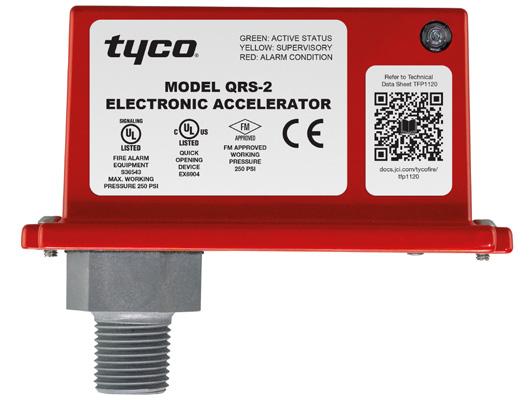
FLEETR THREE MONTH SAFETY CHALLENGE
Fleetr is pleased to have the opportunity to partner with AFSA in promoting enhanced fleet safety and efficiency for all members. The partnership has produced yet another exclusive offer for AFSA members. The three-month free safety challenge is now available.
With this offer, members not only access Fleetr’s fleet tracking technology at no cost for three months but may also qualify for ongoing Fleetr fleet tracking at no cost (with a Fleetr commercial auto insurance purchase). There are no tracking device costs, shipping fees, or contracts. To take advantage of this three-month free trial, visit Fleetr. com and apply promo code INSURE3. For any questions, call (305) 9018744 or email sales@fleetr.com.
Using built-in low- and high-pressure alarm supervision, the QRS-2 Quick Release Switch automatically adjusts to small and slow changes in system pressure by sampling air pressure three times per second. When the device records a steady drop in pressure, as in the case of sprinkler system operation, it sends a signal to release the valve. Electric release technology helps reduce accelerator operating time and false trip issues that often occur with traditional mechanical switches.
The QRS-2 Quick Release Switch can be used with Tyco DPV-1 dry pipe valves and DV-5A automatic control valves and is an integral part of the Tyco QUELL cold storage fire protection system. Its unique design gives it the ability to control up to two QRS-2 switches on one to two system risers, or up to four QRS-2 switches on one to four system risers, depending on the specific riser and releasing panel combination. The QRS-2 Quick Release Switch comes fully assembled with battery backup in case of primary power failure. The device is UL Listed and FM Approved. Visit tyco-fire.com. n
44 SPRINKLER AGE | MARCH/APRIL 2024
NEWS

Fire Pump ITM Workshop
AFSA’s Fire Pump ITM Workshop provides ITM technicians, Authorities Having Jurisdiction (AHJs), and facilities managers with comprehensive knowledge and practical skills for fire pump installations and the necessary ITM procedures.
Participants will understand the key differences between diesel and electric-driven fire pumps, engage in hands-on exercises to perform no-flow and full-flow fire pump tests, and ITM requirements for water storage tanks. Hands-on activities, including energy diffuser selection, data acquisition, supply graphing, and data interpretation.
April 18 -19
May 8 - 9
July 23 - 24
August 19 - 20
September 5 - 6
November 19 - 20
www.firesprinkler.org/firepump
UPCOMING COURSES
Learn More
EARN 1.6 CEUs 16 CPDs 16 Contact Hours 2 DAY HANDS-ON COURSE
AFSA’s New Training Lab GET THE TRAINING YOU NEED!
Held in
SFPE FOUNDATION AWARDS THREE RESEARCH GRANTS
The SFPE Foundation, a charitable organization dedicated to enhancing the scientific understanding of fire and its interaction with the social, natural, and built environments, proudly announces the funding of research into several projects in alignment with its commitment to the Grand Challenges Initiative research agenda.
The Environmental and Health Impacts of Thermal Runaway Events in Outdoor LithiumIon Battery Energy Storage System (BESS) Installations Project aims to better understand the health and environmental aspects of li-ion BESS fires such as products of combustion, factors that influence propagation, and firefighting tactics. The project team will use this information to model li-ion BESS fire plume dispersion. They will use the models to develop a risk analysis of the health and environmental impacts of such fires.
The objectives of the Fire Testing of Resilient and Sustainable Building Materials Project are to identify the sustainable building materials being used in construction, the fire testing methods being used for those materials, and potential fire risks that are not addressed in existing testing methods with further experimental fire testing. In addition to advancing the GCI research agenda, the project contributes to the Resilience/Sustainability and Building Fires threads of the SFPE Research Roadmap.
The Interface Between Digital Buildings and Fire Service Operations Project’s primary goal of this research project is to study the flow of digital information from smart buildings to the fire service and how it can be optimized. A specific interest is the integration of data from tools for Smart Firefighting and their usage by incident commanders. Visit sfpe.org/foundation.
NFPA WEBSITE RELAUNCH
The National Fire Protection Association® (NFPA®) has relaunched its new website—NFPA. org—to provide a more seamless path for stakeholders to interact with the association. The redesigned site, with its dynamic design, improved site performance, and enhanced content, focuses on the organization’s mission to eliminate death, injury, property, and economic loss due to fire, electrical, and related hazards.

WATTS CELEBRATES 150 YEARS
Since 1874, Watts has been delivering innovative water technologies that make the world’s most precious resource safe and accessible. As Watts enters their 150th year in business, they would like to extend a most sincere “thank you” to customers, representatives, employees, and stakeholders for being an integral part of the company’s journey.
Watts plans to host several celebratory events throughout the year, including a yearlong sweepstakes for customers and a celebration at their headquarters in North Andover, Mass. Visit watts.com/150years.
GROUP HEALTH INSURANCE
Mass Marketing Insurance Consultants, Inc. (MMIC) has provided AFSA members with insurance brokerage services for several years. With health care increasing over twice the cost of inflation in recent years, affordable health insurance is essential and hard to come by.
Researching health insurance can be tedious and frustrating, AFSA has partnered with MMIC to help its members find the right plan for themselves or their employees. A resource at their fingertips. AFSA members can receive a free, no-obligation quote through MMIC. Complete a proposal request form by visiting mmicinsurance.com, and MMIC will send proposal rates that best fit your needs. Call 1-800-3491039 or email mmic@mmicinsurance.com.
SFPE LI-ION BATTERY FIRE SAFETY SYMPOSIUM
The Society of Fire Protection Engineers (SFPE) invites fire protection engineering professionals to the SFPE Engineering Solutions Symposium for Progress with Li-Ion Battery Fire Safety: Engineering Solutions to Mobility and Storage Hazards, on June 4-6, 2024, in Phoenix, Ariz. As the world embraces renewable energy sources, the demand for energy storage solutions, especially Li-ion batteries,
has surged. With increased adoption comes the imperative to understand and mitigate potential fire hazards linked with these technologies.
Identified as a top priority for investment in research and education over the next decade by the SFPE Foundation’s Grand Challenges Initiative (GCI), this symposium aims to address crucial fire safety concerns associated with Liion batteries.
The three-day SFPE Engineering Solutions Symposium brings together fire safety experts, engineers, researchers, and industry leaders to discuss innovative approaches and best practices for ensuring the safety of these systems. Early-bird registration discounts are available through May 1, 2024. Visit www. sfpe.org/liionsymposium. n
46 SPRINKLER AGE | MARCH/APRIL 2024 INDUSTRY NEWS
AFSA43 BC AGF MANUFACTURING, INC. 17 ARGCO 43 BAVCO 33 BULL MOOSE TUBE CO. 3 EASYFLEX IBC FAYETTE PIPE 25 FERGUSON FIRE & FABRICATION 4 GENERAL AIR PRODUCTS, INC. 11 HARRINGTON STORZ CONNECT 27 METRAFLEX 29 NATIONAL APPRENTICE COMPETITION 42 NATIONAL FIRE PROTECTION ASSN. 31 REED MANUFACTURING COMPANY 15 RELIABLE AUTOMATIC SPRINKLER CO. IFC VICTAULIC 7 VIKING CORPORATION 9 ADVERTISERS




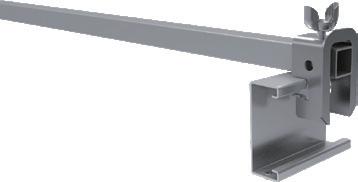
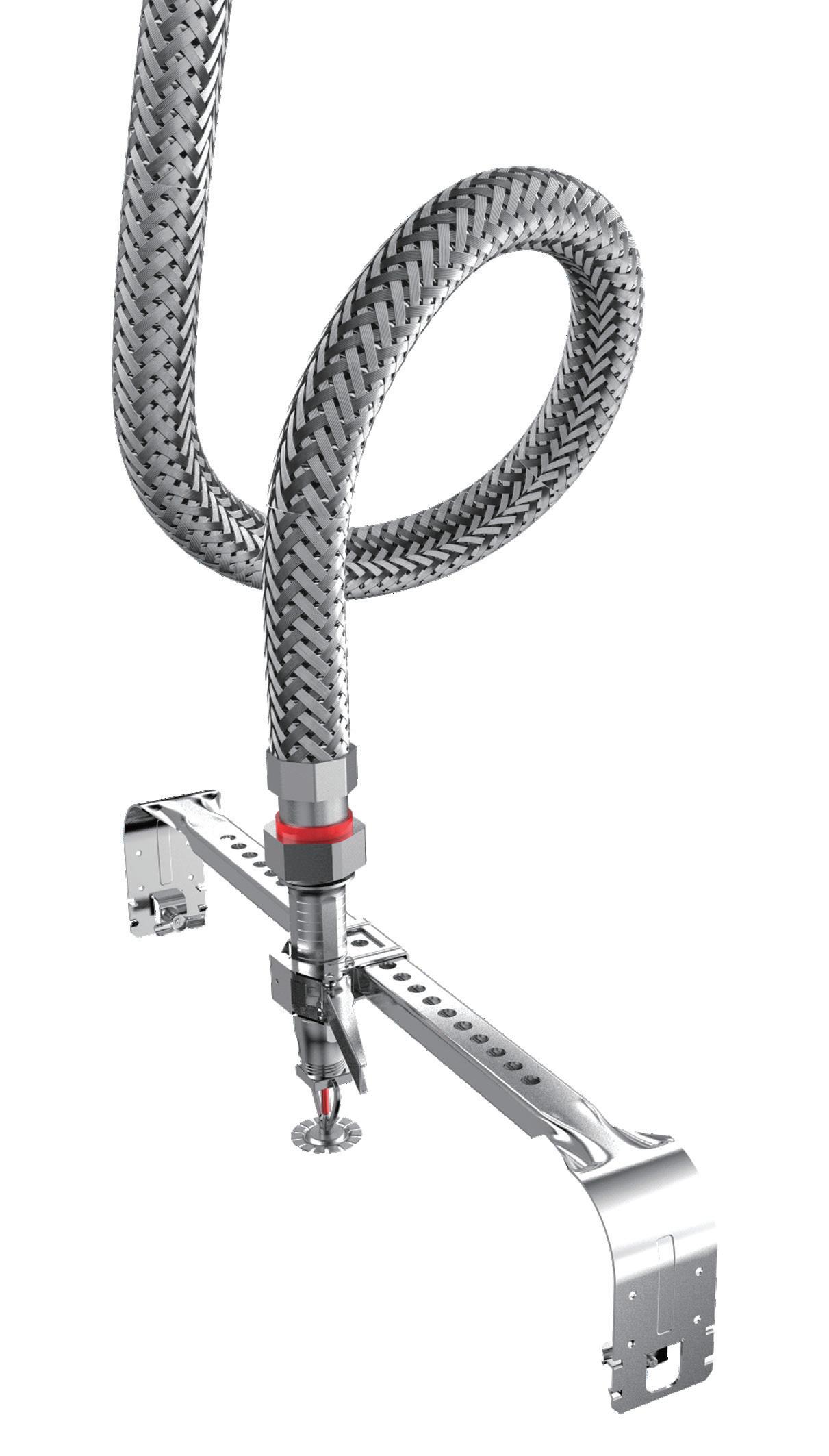




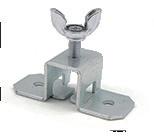



SEP 18-21 2024 GAYLORD ROCKIES RESORT DENVER 43 CONVENTION, EXHIBITION & APPRENTICE COMPETITION firesprinkler.org/AFSA43
ADVENTURE AWAITS













































































































































